GHOST TOWN CALICO: A PHOTO SERIES

THANK YOU, STRANGER
DIRTY CASUALʼS GUIDE TO FRESHMAN YEAR

STYLE WAVES:

SOCALʼS LAID BACK FASHION How

The pursuit of truth: To show students the wide range of experiences life has to offer.

GHOST TOWN CALICO: A PHOTO SERIES

THANK YOU, STRANGER
DIRTY CASUALʼS GUIDE TO FRESHMAN YEAR

STYLE WAVES:

SOCALʼS LAID BACK FASHION How

The pursuit of truth: To show students the wide range of experiences life has to offer.
 Zipporah Marse re-examines Calico, a tourist ghost town she often visited as a child, and shares its history. To read more, turn to page 34.
Zipporah Marse re-examines Calico, a tourist ghost town she often visited as a child, and shares its history. To read more, turn to page 34.
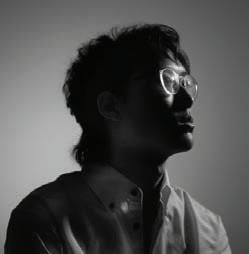
Well, I hope you like the new cover.
The new look for Pursuit has been a long time coming. Avid readers of the magazine (non-existent) will know that Pursuit has gone through many changes in the past four years, comparable to the emotions of a hormonal teenager going through puberty. Now, this isn’t the fault of anyone specifically, but simply a product of the constant changes in students, the department and, most importantly, the times. (And this is the part where we mention COVID, but quite frankly I’m pretty tired, so I’m going to skip that part.) The plethora of changes in Pursuit reflects the changes the world went through in such a short period of time.
When I first joined as a design editor two years ago, I was obsessed in trying to find the “look” of Pursuit. I had noticed the magazine had shape-shifted in so many different ways that it just ended up lacking a specific feeling. In trying to be so many different things, the magazine had lost an identity. So that’s what I’ve been working tirelessly on for the past year or so, creating a final “look” and “feel” that would define the magazine for years to come. But, it is only now that I have realized that task is impossible.
Pursuit, at the end of the day, is a collegiate magazine at CBU. The very nature of a collegiate magazine should reflect what it is like to be at a university. Although the university can’t promise you a specific career, it does promise to provide an education — an education filled with experiences and people that will inevitably change the person you were when you first arrived as a freshman. You change friends, responsibilities, habits and even your dreams. So as I accept the changes my friends and I went through in college, I must also accept the ever-changing nature of the magazine.
At least that’s what I thought.
Being an ill-prepared procrastinator, I sat down and read every single editor’s note in the history of Pursuit. I did this in hopes that I could gain some kind of insight into writing an editor’s note. By the end of the binge, I still didn’t know how to write an editor’s note, but I did notice one thing: Despite all the changes Pursuit went through in the past 13 years, the people that worked on the magazine still continued to pursue all that was true, good and beautiful. It was this belief that informed their every creative decision and change. It is the same belief that was held during the making of this issue, the issue you now have in your hands.
At least that is what I hope.
Editor-in-ChiefManaging Editor
Madison Kirkland
Photo Editor
Camille Grochowski
Design Editor
Leonor Medrano
Assistant Design Editor
Hannah Daily
Section Editor
Jameson Showers
Staff Designer

Staff Writers
Grace Crandall
Zipporah Marse
Emily McGinn
Landon Cole Dacus
Contributors
Elijah Martinez
Nolan Lamberth
Paris Redjai
Publications Secretary
Casey Maldonado
Bryce Robinson Advisers
Sonya Singh
Abigail Wolf
Billowing clouds of white protrude from the mountain line. Blue traces the jagged peaks ‘til the setting sun sinks beneath.
Look! Colors erupt like a volcano coughing up golden gray and molten rosé.
Look! The hills huff fiery flames fume and flare-up spewing scarlet and rustic red.
Look!
I interrupt surrounding chatter and point up but, alas, dusk comes to an end.


For a moment, be still, and remember the people who showed you kindness when you needed it the most. The everyday folks, the quiet presences that changed your life in ways they will never understand. Which one of these people would you go back and thank? Which ones do you wish you could see one more time?
Would it be the acquaintance who once gave you such a shining compliment that you still remember it now, five years after you last crossed paths? Or the coworker who remembered your name on your second day? The one who said, unintentionally, “I see you; I remember you.” What about the classmate who messaged you whenever you were missing from class, proving that “yes, people do notice my absence?” Or perhaps that one friend in the group who kept listening even when everyone else talked over you.
Do you remember these people? Of course, you do. To be human is to be sewn together by the small kindnesses of innumerable strangers. Some stick out more than others, but even the briefest connections are capable of creating a life-long positive impact. Every person, regardless of their story, has a list of characters who aided them along the way. In order to highlight the stories of just a few of these strangers, I sat down with four different people and asked them this simple question:
“If you had the chance to go back and thank someone who was only in your life for a brief period of time, who would it be?”
The responses both amazed me and confirmed my suspicions: We are all made up of the radical kindness of those around us. Through the stories of a woman with terminal cancer, an amiable coworker nicknamed “Grandpa,” a choir teacher’s encouragement and a motherly Thai woman, we can glimpse the power of remembering names, noticing others, reaching out and sharing a bit of ourselves.
The Boy, a Stranger and Cancer
What could a talkative third-grade boy have in common with a twentyyear-old woman? The answer is cancer.
Elijah Jones, a second-year Bachelor of Applied Theology major, spent much of his early life in hospitals being treated for leukemia — blood cancer. While other children were enjoying field trips or eating lunch together, Elijah was enduring chemotherapy and blood transfusions. In the blink of an eye, he was separated from the usual experience of childhood.
But Elijah won that battle. The cancer is gone, and he now sits beside me, his lanky body curled comfortably into the oversized, plush chair. It is so strange and so wonderful that he is here, alive and bursting with enthusiasm. There are many people to thank for bringing him to this interview: the doctors, the nurses, the scientists, the blood donors. But there is one person who, in her quiet consistency and stubborn kindness, helped to carry Elijah forward.
“I remember when I was in oncology, and I was getting an IV of someone else’s blood,” Elijah begins. “There would always be this one girl, either 18 or 20 [years old]… and I would always say ‘hi’ to her.”
That’s where their friendship began. That’s where many friendships begin: in the quiet understanding that, day after day, you will see one another. Even if you have nothing in common, the shared experience of showing up is a powerful tool for connection. Consistency is a form of kindness, and, in the midst of cancer, it is a comfort. No one knows this more than Elijah who, out of the days of chemotherapy and blood transfusions, still remembers the face of his kind friend.
“I know that she had... Cancer,” Elijah says. He knows, because, in true elementary-aged fashion, he asked his mom, loudly and pointedly, “Why does her arm look weird?” The woman only
laughed before taking the time to explain why her face and arms were covered in inflamed, redyellow areas, and why, sometimes, she wore long T-shirts under her short-sleeved dresses.
“I’m similar to you. [Just] a little bit different,” Elijah remembers her saying.
After that, Elijah watched for her. There isn’t much you can do to save another person facing cancer, but you can look for them in a crowded room. That is exactly what Elijah did. He would make a note of every day that the woman was at the oncology center.
During those long weeks, Elijah began to speak with her more frequently. Together, they would discuss his classes, his life and his interests. He remembers her laughing and saying, “you’ll need all of this one day,” whenever he complained about the things he was learning at school. Their conversations were small, but he remembers them vividly.
Then, one week, during his increasingly frequent blood transfusions, the woman’s regular spot was empty. Elijah, hoping for the best, dreaming that she had recovered and been sent home, asked a nurse, “Do you know where she is?”
The nurse, with the apologetic head tilt of an adult who knows something a kid does not, looked at Elijah’s mom and then said, “She’s doing something else, now.” That was that, and Elijah moved on.
It wasn’t until years later that he realized what had really happened. “I wish I could have told her thank you,” he says, his voice thick with emotion, “before she passed away.” He says he knows, now, that she did pass away. That the look the nurse had shared with his mom had meant the worst.
“She was so impactful because it was someone other than my mom, someone, other than a nurse, that was talking to me,” he explains.
When asked what he would say to her if given
the chance, Elijah replied:
“I just wanted to say thank you. For being my first friend, in a way. Thank you for being you. [It meant a lot] for a young kid to be able to go to a hospital and… almost have a family.”
Despite the overwhelming experience of being hospitalized, Elijah still remembers a kind woman, her gentle voice, and the way she made him feel at home when he was at his sickest.

In order to eat, drink and live, we rely on the people who work the humble jobs that keep our world running. Karisma EsparzaNegrete, a freshman architecture major at CBU, remembers her coworker, affectionately nicknamed “Grandpa,” who was one of these people. He spent most of his days behind the scenes at Stater Bros., getting paid to cut meat and manage the younger employees. What he wasn’t paid for, however, was the encouragement that he gave to those around him.

“He was like a grandpa. We called him Grandpa,” says Karisma. Grandpa had initially pushed against the nickname, before reluctantly accepting his role with the grace of someone who had always been ready to take it. “Once a week we would have coffee, and he would just talk to me about life, and why I shouldn’t give up, and why the world has so much to offer, and why I shouldn’t just stay in the position that I am, especially if I’m going to be unhappy.”
Karisma’s description of Grandpa is peppered with memories of his brightness: “He would always come in every day with a smile, bringing so much joy and bringing light... He was very fun and very charismatic. ... He had a lot of joy. ... From his smiles to his laughs to his jokes, he was always very welcoming and warm, very warm.”
But while Grandpa did have a lot of joy, he also had his regrets. “Some days he was really grumpy… but he never made us feel like we were the reason why. He had [just] gotten stuck in the job… after he came out of the army. He never had the chance to keep building because he started having children.”
But despite his disappointment in his own journey, he never stopped speaking encouragement to Karisma. “He always told me and my coworkers to never give up on our dreams, and he was very passionate about us, about [telling us to] keep going and to not get stuck, because he had past experience.”
Karisma attributes returning to college at 24 to the push she received from Grandpa: “He was actually the reason why I left my job at Stater Bros. [And] if I was at Stater Bros. still, I probably wouldn’t be where I’m at today. A lot of the people he would talk to — a lot of them would start going back to school.”
Grandpa passed away around a year ago. To Karisma, though, his impact remains. Last fall, she was accepted at CBU. “He was one of the first people I texted. Even though he had passed away, I still texted the phone number. I said, ‘I just want to say thank you.’”
Grandpa pushed Karisma to escape the mundane and encouraged her to pursue what he knew was waiting for her. Through this all, he put himself last, viewing himself as a lost cause. But that is not what Karisma saw:

“He would say all the time, ‘Don’t give up. Don’t be like me.’”
“I thought, ‘But I want to be like you.’”
Isabelle Ray, a junior creative writing major, sits across the table, her eyes bright and sparkling, her voice strong and grounded. There is no sign of shyness or hesitancy in her laughter or gestures. But, according to Isabelle, things used to be different. The Isabelle who joined a choir in Germany during her junior year of high school was quite opposite from the one sitting across from me. “I had always loved singing,” says Isabelle, “but I was also super quiet, and shy, and I was not able to sing… boldly.”
There was a block in front of her, a lack of confidence that held back her voice. It wasn’t until meeting Mr. Loe, the choir teacher, that she was able to overcome that lump of anxiety in her throat. Mr. Loe was a quirky man who wore funny socks and a pair of glasses, a teacher that “was just so sweet and happy” in everything that he did.
Isabelle remembers his classes fondly, although they only took up an hour of her week. Such a small amount of time, and yet, “he would try and get to know us,” she says. “Try and push us a little bit.” Mr. Loe chose to spend his precious hour on intentionality, part of which was encouraging every single student to audition for the choir. “He would go person by person and [ask], ‘do you want to try out? Do you want to try out?’ It would take a lot of time, of course, but it was a very intentional move. You may not feel brave enough to raise your hand, but if you were intentionally asked, you would say yes.”
“I have no idea if he was a Christian or not,” she says, “but I wouldn’t be shocked if he was, because his demeanor was just…” She trails off.
I am sure we all know what she means: there are some things, some markers of the Christian faith, that just cannot be described. That inexplicable joy, that enduring kindness. “His son had cancer,” she shares, “but you would have never known by his demeanor. He never acted like he had this burden on his shoulders, of sadness.” There was an untouchable, recognizable light that pervaded his presence.
His encouragement worked. “I ended up feeling an ounce of confidence,” Isabelle recalls. “When
he went around for solo tryouts, I said, ‘OK, I’ll go.’ He was completely surprised, but then he pushed me. It was the most nerve-wracking thing ever. I was so scared. [But] he would always talk with me, and [say], ‘you need to have more confidence in yourself.’ That really transformed my confidence, especially relating to singing. Now, I really have no care if people hear me.”
Isabelle can see how this push to confidence influenced other aspects of her and her classmates’ lives: “I think once you have confidence somewhere, at least it’s there because it’s much harder to [initially] find [it]. Once you have the discovery, now you’re like… ‘I know what it’s like
to have confidence in singing, so if I really rely on that, I can build more confidence in being an RA, or confrontation and all of that.”
For one hour a day, one day of the week, Mr. Loe would show up, brimming with encouragements, ready to see each student with the intention that only true kindness can foster. There was a strength in his being that amplified Isabelle’s heart and voice. Just one hour of a week, and she still remembers him now, even as she is sitting at another school in another country, far from the place and time where Mr. Loe taught her what she now knows about singing — and confidence.

Mante Petersen, a graduate student in counseling psychology and counseling ministry at CBU, responds to my question with a simple sentence: “I want to talk about my host mother in Thailand.”
From 2016 to 2018, Mante served as a Youth Development Worker for the Peace Corps, a government agency that trains and deploys volunteers in order to assist developing countries.
“I was… working in a small village, teaching children English and life skills, training young Thai children to become leaders. I did this in a rural village in the Gulf of Thailand,” he explains. “This was a time in my life where I learned to be resourceful, [to] have resiliency. I learned about the capacity of love. I learned about compassion.”
A large part of this love and compassion came to Mante in the form of a seventy-something Thai woman with rough hands and a raspy voice. “The name for ‘mom’ is ‘meh,’ and I would call her Meh,” says Mante. “I spent 27 months in Thailand. My first three months, [during] the time I spent learning the language and getting accustomed… even in regards to my darkest times in culture shock… Meh was the one who got me through.”
Mante remembers the challenging of his identity in Thailand, especially in conjunction with the injustices occurring back in America. “In the United States, there was a lot of racial unrest. I was still connected with people back home, and there was… a darkness, even a survivor’s remorse… of being in a place like Thailand.” Not only was Mante having to adjust to a culture outside of the United States, but he was coming to terms with the reality of being the only Black person in the village where he lived. In the midst of this loneliness, and despite their differences, Meh took Mante’s uncertainty into her calloused hands and sat with him in silence.
“I think I came in with insecurities,” he remembers, “[and] what my host mom did was she met me with love, dignity, curiosity, and a genuine sense of warmth. From the small things of making a meal, to just being in silence with me on those lonely nights when I would cry myself to sleep from being homesick.”
“From a cultural standpoint,” says Mante, “she did things that were atypical for a Thai woman… [it was strange] for an older woman to have a young man in the house. But I was recognized as her son.” Mante’s filial relationship to Meh acts as proof that there is no cultural barrier that love cannot cross.
But while love doesn’t end, it does change. Now, rather than being with Meh in the present, Mante loves by looking back: “The reason why I will never be able to say thank you is when I left Thailand, I knew that it was important for me to let that experience go.” Mante doesn’t know where Meh is, how she is doing, or if she is even still alive. Because of his choice to disconnect from social media, he doesn’t have a link to anyone from his past in Thailand who could tell him these things. But what he does know is that the love for his host mother has remained.
Life moves on, and the illusion of social media

has convinced us that it doesn’t, that we are meant to be bound to the people of our past forever. We wonder if our love doesn’t mean as much if we say goodbye for good. But Mante doesn’t see it this way: “For me, making the decision that I wouldn’t be on social media was also a decision that there was a lot of people from my past that I would never have the opportunity to speak to again… That, for me, has been the hardest part of making a decision that I thought best for my mental health… But there’s a human aspect of allowing relationships, friendships and loved ones to remain in the past. To just be seasonal, rather than forever.”
Mante pauses to make room for memories. It is obvious that his act of letting go did not mean forgetting. There is only warmth and emotion in his voice when he says, “I was known as her son, and it was a beautiful thing.” Wherever Meh is, she must be holding a matching memory close to her, although her time with Mante has since passed.
Even if Mante wanted to return, he doesn’t think he could. “There comes a point where you lose the language. There comes a point when the things that were so heavy on your mind… you begin to lose them.” Here he is, encountering the grief that comes with inevitability, choosing to accept its course. When asked what he would say to Meh if given the opportunity, Mante pauses. Then, with tenderness, he speaks the language he is already beginning to forget:
I am good. I love you, mom. I love you forever.
Thank you, Stranger
All of the strangers in these stories have something in common: they will never know the extent of their impact. Whether it be because they have passed on, moved on, or are simply subject to the human tendency to forget kind truths about themselves, they will never grasp what their words and consistency meant to those around them. Remember this the next time you feel small and insignificant: you don’t know who is looking for you in a crowded room.
Finally, as an exercise in love, be still and choose to intentionally remember that teacher, coworker, acquaintance, friend, classmate or peer who, in unwavering goodness, continued to meet you the way that Meh once met Mante: “with love, dignity, curiosity, and a genuine sense of warmth.” u
 Written & Photographed by Camille Grochowski
Written & Photographed by Camille Grochowski

The last thing any cast or crew member wants is for something to go wrong in the middle of a live performance. The world of live theater is brought to life through weeks of long hours and repetition, all for the purpose of putting on an unforgettable act. Still, it is likely that someone’s pants ripping or a prop breaking on stage is memorable in its own way. There is never a perfect run of any show, and in most cases, the professionalism of the cast and crew means the audience does not notice if something goes wrong. But what if the show is supposed to go wrong?
“The Play That Goes Wrong” is exactly what it sounds like — a farce in which everything goes sideways. From actors forgetting lines to walls crashing down, there are nearly 170 gags that happen from start to finish that end in a set left in pieces and the backstage crew “unintentionally” joining the actors on stage.
The play first debuted in 2012 in London. Five years later, it hit the Broadway stage on April 2, 2017. Now, “The Play That Goes Wrong” made its debut at California Baptist University’s Wallace Theatre. Lee Lyons, director of the CBU theater program, is both the play’s director and set designer.
Lyons has been in the industry for more than 35 years. In that time, he has worked in nearly every role backstage. Whether designing both the lighting and sound or designing a set alongside directing, there is little that Lyons has not done within the technical side of theater. In this show particularly, it is a benefit to be both the set designer and the director because the roles require constant communication.
“It allows me to solve all the problems because I’m already seeing what the director needs to have happen,” Lyons says.
He has never directed a show twice, so “The Play That Goes Wrong” is a new experience. During his time as a professor at California State University San Bernardino, where he taught for 20 years, Lyons directed a show similar to this one called “Noises Off.” He refers to both of these plays as backstage comedies that allow the audience to see the chaos behind the curtain. In “Noises Off,” the set turns around and shows the hustle and bustle of live theater behind the scenes during one of the acts, but in “The Play That Goes Wrong,” the backstage life is exposed differently.
“We kind of show everything in one set,” Lyons says. “The set is all dressed, and then at different points, it starts to fall apart, and we get to see deeper into backstage.”

The main theme of “The Play That Goes Wrong” presents a theater troupe known as the Cornley Polytechnic Drama Society, who visits their sister school, CBU, to perform “The Murder at Haversham Manor.” It is a murder mystery written by the fictitious playwright, Susie H.K. Brideswell. Unfortunately, their set is stuck at the Los Angeles harbor, so CBU has built them a replacement set in under four days. As the play goes on, things go south little by little until everything, quite literally, falls apart.
“Normally, when we build sets, we are not intent on them breaking,” Anthony Paulin, the technical director, says.
While a big portion of the comedy comes from the actors’ reactions and stunts, 66 gags belong to the set. Objects fall off the wall multiple times, a bucket catches fire, a door is ripped off its hinges, stage walls fall to the floor and a raised platform collapses while two actors are standing on it. Paulin even cut a second trapped door into the stage floor to allow one of the actors to crawl below the stage throughout the show. Paulin says his main goal is to “build this [set] so it can take a beating night after night,
Trehearsal after rehearsal and not damage the set, but more importantly, not damage the actors.”
Lyons says the set itself is an extra member of the cast. As a character, it appears to have a sassy attitude as it reacts to the actors throughout the show. By intermission, several props have fallen off the wall, and it is the CBU stage crew’s job to put everything back in place during the break. However, it is a wasted effort because everything falls again seconds after the play resumes. It is as if the set is laughing at the crew for wasting 15 minutes of its time.
In another scene, a shield falls and hits one of the actors in the face as he walks into the room. He responds by ripping it off the wall and throwing it off stage. There is also a point in the show when two other actors are trying to hold up props that begin to fall on their own while attempting to answer a telephone call. Finally, at the end of the show, as the character Charles Haversham finishes his big monologue, the chandelier falls right before the lights fade to black and the rest of the cast and crew scream in panic.
“[The set] is a third character,” Annie Gibson, the shop foreman,

echoes. In most productions, it is bad when props become a third character on stage. If a prop is left on stage unintentionally, it distracts the audience and takes away from the important things happening, therefore acting like an additional character. But “The Play That Goes Wrong” flips this idea on its head in a positive way because the seemingly unintentional mistakes are meant to be seen by the audience.

There are many challenges that go into building any kind of set, but this play comes with its own additional set of challenges on top of the usual ones. The main obstacle Lyons, Paulin and Gibson faced during this process was figuring out a way for all the set-specific gags to work. Unfortunately for them, the original script does not have any explanations for how each of the 66 setspecific gags works.
In the script, gags are stated plainly in parentheses, without any guidance on how to make them happen technically. Gibson says the team behind the original show hunts for how-to guides or explanations online and takes them down. This is usually the case for some gag-heavy shows where the original creators do not want to share their tactics.
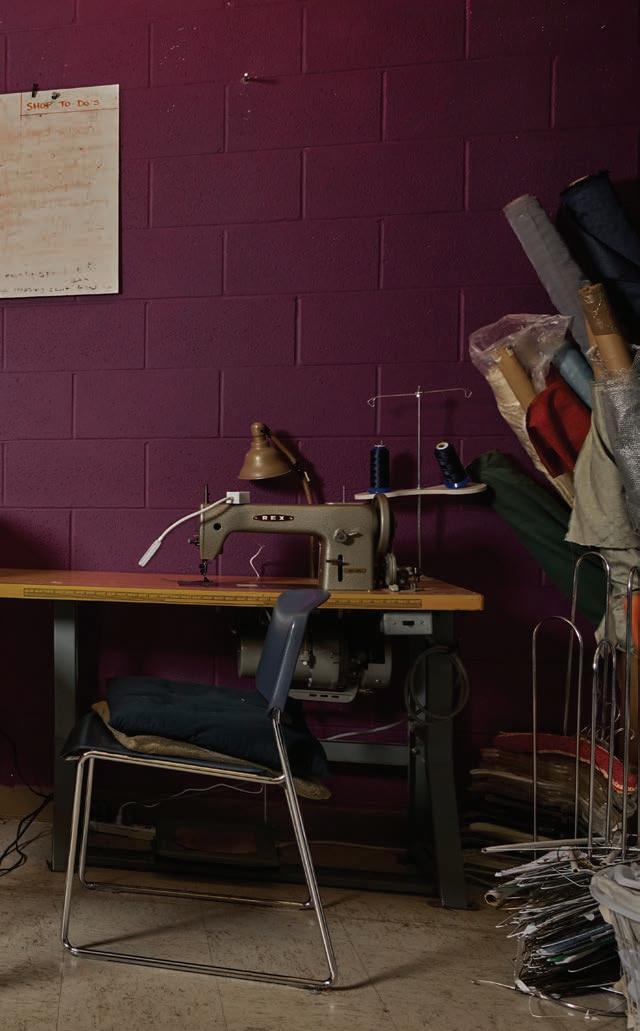
8. Seth Suguitan, sophomore theatre major, gives his character’s final monologue as the chandelier falls above him.


7. Memebers of the CBU Stagecrew cheer on another stagecrew memeber for dancing with one of the actors on stage.
6. Parsio watches Rickert work on a magnet while she pretends to play a -ther mometer as a guitar.
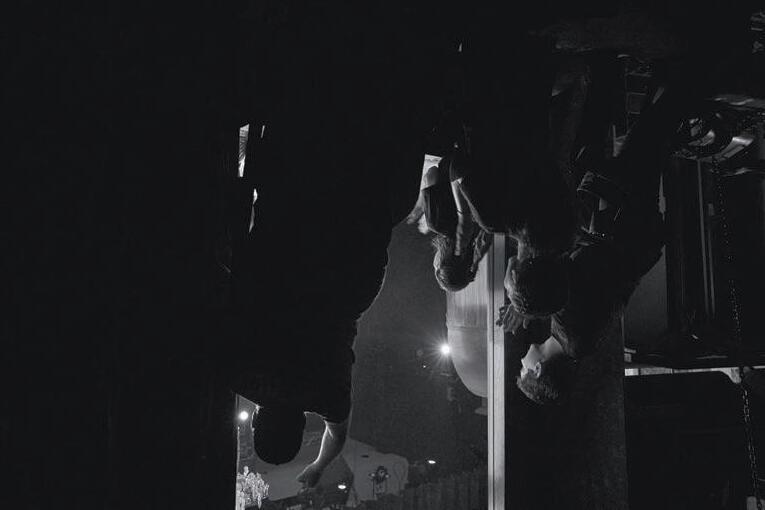
5. Santino Alvarado, freshman film major, sits in the prompter’s box.
4. Chloe Henry, sophomore psychology major, runs backstage after the -back stage crew falls through a door onto stage.
3. Carter Sherwood, junior theatre major, and Taylor Rickert, freshman mechanical engineering major, throw newspaper cuttings into the air to mimic snow fall.
2. Kevin Walls, sophomore civil engineering major, sets the collapsing platform to its second falling stage using a controller connected to the chain motors.

1. Alexis Parsio, junior theatre major, shows off the list of tasks she needs to do throughout the play.
7
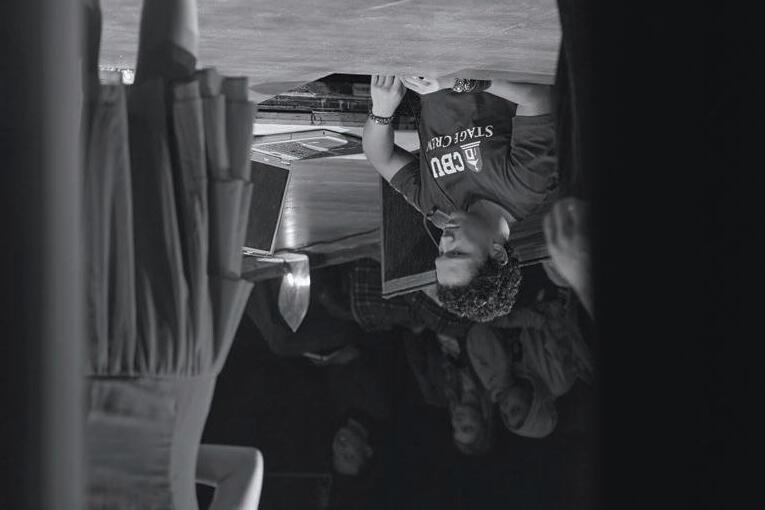
All photos shot by Camille WGrocho
The crew works behind the scenes to make the set an active participant in the play.
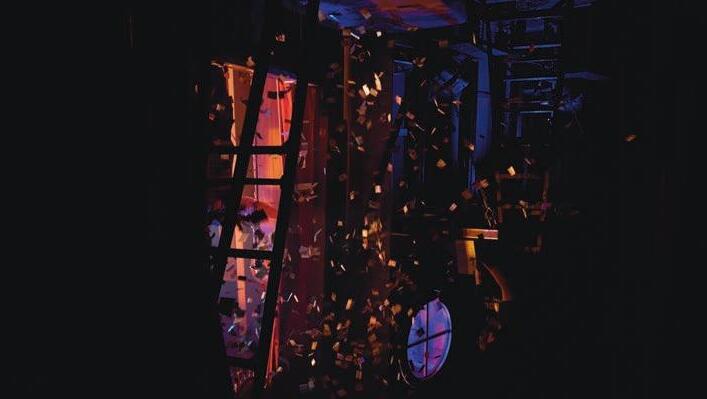




They don’t say, ‘Oh, here is how everything works!’ They leave it to you to figure it all out,” Lyons says. He talks about a specific moment in the show that contains a magic trick. Sandra, an actress from the visiting theater troupe who plays Florence Colleymoore, suddenly appears from inside a grandfather clock seconds after she is seen trying to get through a door on the other side of the stage. The script simply states that she magically appears, not how she makes it back into the clock beforehand. Luckily, Lyons was able to figure out a way for the magic trick to run smoothly without the audience noticing. However, just like the script notes, a magician never reveals his secret.
Most other set-specific gags are technical ones that Lyons, Paulin and Gibson have to engineer their way around. The collapsing platform, for example, uses two chain motors supported by three metal structures. It falls in three stages, meaning the platform needs to hold itself and two actors up in the middle stage. “We’ve got to build it strong for it to do it over and over again… every night it has to go back and get fixed again,” Lyons says. Both chain motors are rated at two tons each, and the maximum amount of weight on top of the platform during its fall is about 600 pounds, so there is more than enough power to allow everything to run smoothly.
They used magnets for props staged to fall off the wall over and over again. However, with heavier props like the shield, they had to find more secure ways to keep it attached to the wall. One of their early prototypes used Velcro to make it easy to pull off the wall, but the shield’s weight proved to be too much. Eventually, they settled on a magnet at the top of the shield with two wooden pieces at the bottom pushed through holes in the wall. This made it so the actor could rip the shield away easily and it could still be placed back each night without too much hassle. This method still left room for some error, though. The rehearsal before opening night resulted in the wood on the back of the shield splitting. Nevertheless, with gags that involve dropping or pulling props off the wall, a little breakage throughout the show is expected.
Kiana Bjur, the costume designer, also had her own wardrobe-specific gags to figure out. While she says that fewer challenges went into the costuming, Bjur adds, “The fun things are when you have a challenge that you’re not expecting.”

Those unexpected challenges came to her in the form of duct tape and colorful scarves. Near the end of the play, there is a scene when an actress gets wrapped in duct tape. Bjur’s main difficulty with this costume was creating an outfit out of duct tape that looked realistic but was easy to take on and off every night. In her final design of the duct tape costume, Bjur used Velcro in the
back so the actress could simply slide it on and off without any trouble.
The biggest challenge Bjur faced was the scarves that an actor pulls out of his pants. This happens after a sword-fighting scene in which one of the characters pretends to die and pulls out red scarves from his pants to symbolize blood. However, as he keeps pulling the scarves out, they turn different colors and he makes a reference to the famous rainbow scarf trick performed by clowns. Bjur’s hurdle in this gag was finding a way to hide the scarves in the actor’s pants.
When it comes to costuming, according to Bjur, theater magic is just Velcro. Just like her solution to the duct tape outfit, she used Velcro to attach a tube to the actor’s pants where the scarves could hide before he pulled them out.
Another unique aspect of “The Play That Goes Wrong” is the backstage crew. Usually, the backstage crew is in charge of scene changes and helping actors with makeup and costumes. They work in support of the actors and are not supposed to be seen by the audience. In this play, the backstage crew is a part of the cast. There are 12 cast members, six of them making up the stage crew team.

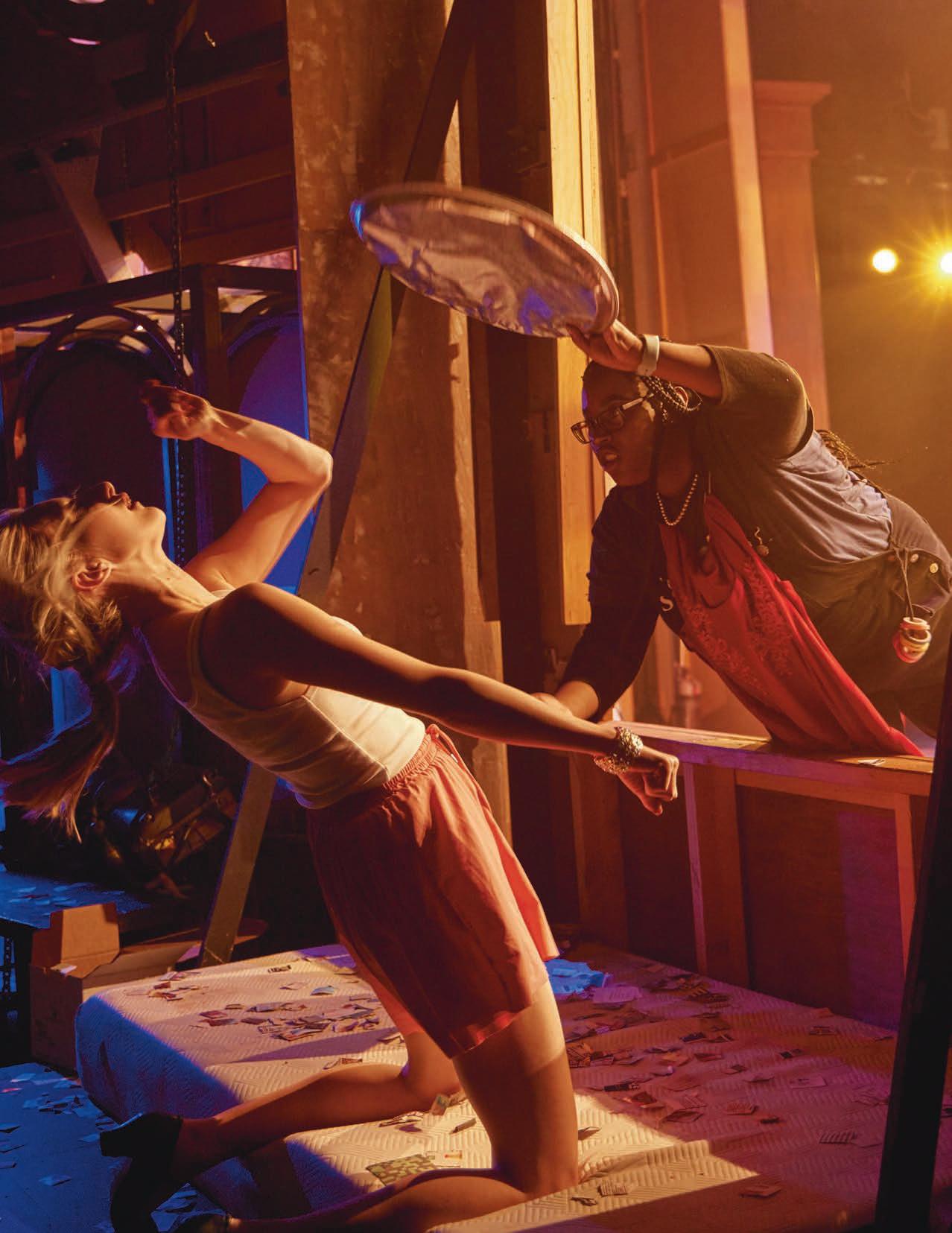 Sabrina Heim (left), freshman theater major, gets hit in the face with a foil tray by Yonika Metellus, junior theatre major, during their characters’ fight over the role of Florence Colleymoore.
Sabrina Heim (left), freshman theater major, gets hit in the face with a foil tray by Yonika Metellus, junior theatre major, during their characters’ fight over the role of Florence Colleymoore.
Yonika Metellus, junior theatre major, plays Annie, a member of the CBU stage crew. She is first seen by the audience as the one in charge of attaching the mantle to the wall, but later on, she is pushed onto the stage by one of the actors to play Florence Colleymoore when Sandra passes out.
This is Metellus’s first big on-stage appearance at CBU. Before this play, her roles at the Wallace Theatre have been ensemble member, assistant stage manager and stage manager. This means she has had experience being a part of the show, but this is her first time getting to dig into a character.
In her first scene on stage, Metellus’s character is hesitant and reads off a script. However, as the play continues, Annie discovers a passion within herself and ends up trying to get the recovered Sandra off stage so she can have her own time to shine. Their feud ends with Annie wrapping Sandra in Bjur’s specifically crafted duct tape outfit.
“I like comedy, and I like adding crazy to it,” Metellus says. “Lee [Lyons] gives us freedom with our characters… we have that creativity in how we want our characters to act.”
YFor Lyons, when it comes to directing a farce, blocking the show requires a lot of strategic placement. In theater, blocking is the process in which actors are placed around the stage in order to determine smooth movement and positions within each scene. In a show like this, there are many precise movements that actors need to make for gags to work.

During rehearsals, Lyons moves pennies around his drawings of the set, each penny having a character’s name on it. With this method, he is able to have them on a drawn floor plan that is to scale and envision where the actors will be, if they are blocking each other or if the set feels unbalanced. As a designer, Lyons focuses on maintaining balance within his productions in order to show the audience the importance of composition and beauty that comes from simply moving people around a stage.
“This is my kind of play, where it’s a farce,” Lyons says. “There’s people having to be in the exact spot in the exact right time. Some directors let the actors find the movement on their own, but this takes time, and this play raced the clock. When the spring semester began on Jan. 9, they only had five weeks to get everything performance
ready before opening night on Feb. 10.
With “The Play That Goes Wrong” as a farce, it was better for Lyons to set the blocking in advance to ensure that gags could run smoothly without the risk of actors getting in the way and putting themselves at risk.
“I am just a traffic cop,” Lyons explains. “I am putting [actors] where I need [them], and then we add all of the layering of emotion and motivation for moving there later.”
In the theater, the common refrain among this play’s cast and crew was, “Hopefully ‘The Play That Goes Wrong’ does not go wrong.” With the number of challenges placed in the way of Lyons and his crew, there were certainly moments of difficulty and problem-solving. But all of that hard work paid off in bringing the show to life on the Wallace Theatre stage.
Despite those challenges, the show’s run from Feb. 10–18 was successful, and “The Play That Goes Wrong” went absolutely right. u
@cbulancermedia on instagram for a prize!
*In honor of The Play That Goes Wrong, this article has also seemed to have gone wrong in several places! Try to ndfi all vefi mistakes in this article and DM

Acotton
This is the list of all the waste I physically threw out in a day in my life on campus. On a university campus, disposable waste is part of everyday life. We grab food in plastic bags, eat with disposable utensils and buy coffee in to-go cups. Massive dumpsters are hallmarks of living areas across camps. For students, having a long list of daily waste is common. In fact, California schools and universities produce 562,442 tons of waste annually, according to CalRecycle.
Schools and universities represent only a fraction of the grander picture of waste production in the U.S. As a whole, the nation produced an average of 292.4 million tons of municipal solid waste (MSW) — a fancy term for all those plastic forks and coffee cups — each day in 2018, or about 4.9 pounds per person daily, according to the Environmental Protection Agency (EPA). As a nation, we produce the most waste in the world. This waste production can lead to environmental concerns when not handled correctly.

“Land disposal and poor waste management causes air pollution, water and soil contamination,” says Dr. Bonjun Koo, professor of environmental science. “Open and unsanitary landfills contribute to contamination of drinking water, methane gas formation [and] migration, and can cause infection and transmit diseases.”
Proper waste management is vital to protect our communities and the surrounding environment, but what does that process actually look like for our trash here at California Baptist University? For most of us, our interaction with our trash ends as we watch it disappear under the lid of a trash can or recycling bin as we head out of El Monte, or as we toss our dorm garbage bags into the dumpsters around our living areas. But the journey for your burrito bowl is far from over.
Ivan Pedraza, environmental health and safety coordinator, sees this behind-the-scenes view of waste management on campus on a daily basis. He says the first step to sending waste where it needs to go is categorizing the waste into three subcategories: hazardous, universal and MSW. Hazardous waste is trash that could be dangerous to humans and the environment, according to the California Department of Toxic Substances Control. Universal waste is a step down from this, containing elements that could become hazardous if mismanaged. For example, batteries, lamps and aerosol cans fall into this category. On the other hand, MSW is the most common form of dayto-day waste, consisting of recyclable materials, general landfill-bound trash and organic waste.
“Hazardous and universal waste are a little more strictly regulated,” Pedraza says. “For example, I have to coordinate with EPA-designated entities — that’s going to be like Department of Transport. There is also the county Department of Environmental Health. The municipal waste is treated in a similar way. It just has to be separated from hazardous and universal waste.”
Federal and state regulations dictate how CBU must manage hazardous and universal waste. When CBU receives hazardous material, it is entered into an inventory before use to keep track of the hazardous material on campus. After use, there is usually a middle stage — a period of time when waste is maintained in a container, such as in a lab, for example — before it is moved to an on-site storage location. Pedraza says that CBU has several on-campus sites for storing hazardous waste. The primary location is Facilities’ Building 16.
“I have to establish what’s called a waste stream,” Pedraza explains. “A waste stream can consist of any kind of waste that can be considered corrosive [or] flammable, and they have special parameters you have to manage them under. Within the waste stream, there are certain profiles — is it a liquid? Is it a solid? What are their hazardous properties? [What are the] best management practices? That’s also something we take into consideration. And that’s just the storage.”


During the storage period, Pedraza has 90 days to schedule with a transporter to move the hazardous and universal material off campus to what Pedraza calls “a final destination” — usually a facility responsible for properly disposing of dangerous materials.
“That’s when you get into the more technical side of things where there are different methods [of operation],” Pedraza says. “Unfortunately, sometimes it [ends up in a] landfill. That is kind of a general industry-wide issue, and a lot of companies are trying to move away from that.”

While everyday MSW does not have the same intimidating “hazardous” title that the other two subcategories possess, the pathway is not much less complex. Pedraza says there are several tools on campus to collect municipal waste, including grease interceptors that collect cooking waste that can often move onto a recycling facility and trash compactors, which make mountains of waste more manageable.
“[The compactor] will compact the waste and make it more transportable, and we can fit more in one shipment,” Pedraza explains. “There’s also a green factor to that — the more often you can have a truck fleet come out or a trash truck come out to pick everything up, it’s more sustainable that way.”
Perhaps most prominently, the campus has waste enclosures — walled-in areas where dumpsters are kept — across campus. These dumpsters collect waste in bulk, which is then collected by Burrtec Waste Industries, a trash company that manages waste throughout the Riverside area.
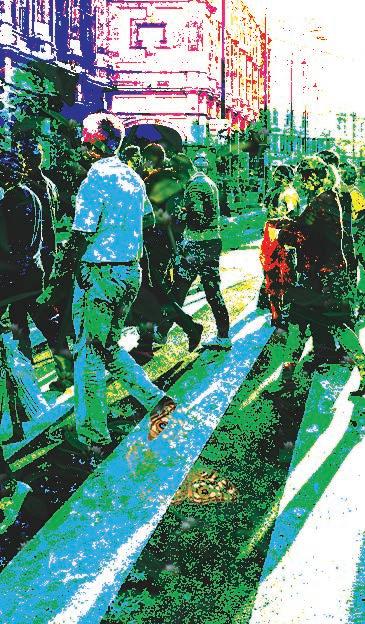
Over the years, recycling became a prominent element of the modern environmental movement. Many of us learned the now-familiar phrase “Reduce. Reuse. Recycle.” in our elementary-school curriculum. Homeowners line recycling bins along the streets beside their trash bins. California made a huge leap toward recycling in 1989 when it passed a law requiring cities, counties and waste management agencies to establish recycling plans that would cut down the state’s landfill waste, according to CalRecycle.
However, Koo says that teaching recycling as a good practice is not enough, pointing out that “most people know that recycling is a good habit for the environment, but are often unsure of what goes into the recycling bin.” Despite major strides in recent decades, the recycling industry is plagued with challenges. Koo says the major issues concerning recycling include a lack of education, which leads to poor quality of recyclables; the safety of workers; inadequate recycling services; and a low demand for recycled materials.
“The top barrier to campus recycling is a lack of reliable, easily accessible information to tell [students] what goes where,” Koo said. “For students, a lack of instruction affects their daily recycling behavior throughout the school year, but it is a particular concern when they are moving in and moving out.”
At CBU, recycling can be a challenge, especially when many people do not necessarily know what is recyclable and what is not. For example, did you know pizza boxes are not recyclable? While cardboard is a recyclable material, pizza boxes cannot be recycled because they are coated in grease and other foodstuff. This contamination can damage recycling machinery and hinder the process of creating new products out of recycled materials, according to City of Riverside Public Works.
Ideally, recycling will occur before trash is thrown away when people place recyclable materials into designated bins. However, this is often not the case. Luckily, there are fail-safes built into the modern waste industry that ensure recycling does occur, even when we might not see it happen. So, no need to feel badly if you threw your last stack of pizza boxes in the “wrong” bin — Pedraza says that the dumpsters in our campus parking lots collect all waste materials, and separation of those materials occurs farther down the line.
“The bulk trash — for example, that Burrtec comes and picks up in dumpsters — that gets sorted out at the waste site,” Pedraza explains.
Burrtec features several types of facilities, including transfer stations, landfills and material recovery facilities (MRFs). These MRFs are where sorting occurs.
“Burrtec’s MRFs sort and process recyclables from general waste,” according to Burrtec’s website. “With the increase in the amount of recyclables being discarded, material recovery facilities play an important role in the process of collecting recyclables to redistribute them to third-parties and reintroduce them to the general public.”
These MRFs display a general shift in the waste management industry. Pedraza notices this transition to more environmentally-friendly practices across the industry as green marketing — or pushing consumers to make purchases based on sustainability of products — and other advancements such as bioremediation — or using bacteria and fungi to absorb contaminants —— becomes more prominent.
“Ultimately, there’s been a lot of effort to recycle our waste,” Pedraza says. “That’s a huge thing. I think you’ve seen a little bit of that green marketing going on — with shoes, for example, that are being made from recycled materials captured from the Great Pacific Garbage Patch.” Even though there has been a shift, Pedraza says the waste management methods have not changed much. While the industry has woven environmental practices into its methods, some waste ultimately ends up in landfills. “It’s more of how we develop material [and] how we reuse materials,” Pedraza says. “As far as where waste ultimately ends if there is no redeemable practice, it can and will be either incinerated or in the landfill. That’s kind of the last option, so to speak.”
Like most things, the waste industry was impacted by the COVID-19 pandemic. The use of disposable masks and packaging became commonplace to slow the spread for the sake of safety, which led to a setback on the environmental front.
“We found that the quantity of waste increased across countries observing the social distancing measure of staying at home,” Koo says. “The intensification of single-use products and panic buying have increased production and consumption, hence thwarting efforts toward reducing plastic pollution.”
During the pandemic, take-out meals and groceries delivered to homes caused plastic packaging production to spike. A September 2020 article in Science projected an annual growth rate of 5.5% in the global plastic packaging market
due in large part to the pandemic lifestyle shift.
As a member of the environmental health and safety community, Pedraza says that the pandemic “produced a bit of a scramble” and created a dilemma over how to properly manage this new waste stream.
“There is a debate: Do we value protection over environmental sustainability?” Pedraza says.
However, as the pandemic wanes and campus life returns to normal, Pedraza emphasizes the school’s continued mission: “the protection of Creation.”
“We take a lot of pride in the appearance of the campus,” Pedraza says, “so that alone is a driving force of having a more ecologicallyfriendly campus.”
(Yes), Newspaper (Yes), Packing Peanuts (No), Tissue Boxes (Yes), Plastic Lids (No)
Glass Bottles (Yes), Hard Cover Books (No), Pizza Boxes (No), Shampoo Bottles
While the U.S. faces a daunting trash challenge, people can chip in to help. The first goal is to minimize the production of waste. Pedraza says this prevention step can be as simple as asking yourself: “Am I using too many napkins?”
“You really have to establish: What is your waste? Before you even get to that point, you can go back and consider, ‘Well, do I need to use this? Is this necessary? Am I using too much?’” Pedraza says.
Pedraza also emphasizes the same prevention mindset for hazardous waste.
“We only want to create small quantities of hazardous waste,” Pedraza says. “It’s always best to keep it that way. So if you have a managing practice that could reduce hazardous waste, and that could be done by substituting chemicals — so rather than using a corrosive or anything that is volatile, for example, you can substitute for a more organic material — that’s an example of substitution and managing the amount of waste we create.”
Pedraza also recommends reusing whenever possible. Using reusable materials is not only environmentally-friendly, but also cost-effective.
If waste production is not preventable, the next step is consolidation.

“When you consolidate your waste, you should consider: Where does this need to go?” Pedraza advises. “How do we categorize this waste? Is it universal? Is it hazardous? Is it foodstuff? Is it recyclable? If it’s a recyclable, we all grew up learning to put it in the blue bin.”
For Pedraza, the key to doing your part often lies in the small things — even the things that seem insignificant — like using a reusable water bottle and keeping trash bin areas clean to avoid the spread of loose trash. Even just bagging your trash can help ensure it is transported safely to trash facilities without escaping into the environment.
“Here, we have the Santa Ana winds,” Pedraza says. “A lot of trash bins get knocked over and trash gets loose and flies into the wind and gets carried off. So having bags to contain that can [help].”
Koo also suggests several practices that college students can actively employ, including joining clubs such as Tree Campus USA to maintain an eco-friendly campus, reducing and recycling paper, conserving resources, purchasing sustainable and recycled items, reducing food waste and limiting what you purchase so you only buy what you need. He also recommends integrating recycling into one’s regular routine.
To properly recycle, Pedraza recommends looking into resources, such as the City of Riverside’s website, that explain what can and cannot go into a recycling bin. Ultimately, taking small steps to help minimize waste and manage it properly fits into Pedraza’s mindset of environmental stewardship of Creation.
“Doing a little bit of research and educating yourself on what you’re using and where it needs to go after is a big part of it, I think,” Pedraza says. “It’s essentially embodying the values of a steward. It’s stewardship really that it comes down to. It’s doing your due diligence of understanding what you’re doing and how it affects the environment.” u

I woke up to rain today. I fell asleep to rain last night. Closed my eyes to the season and opened my heart to a new one. It feels like every year second chances turn to third, fourth, fifth, sixth, seventh, eighth, ninth, tenth, eleventh, twelfth, thirteenth, fourteenth, fifteenth, sixteenth chances.
So far, each new chance is a chance to Forget. Forgive. Forego. Forever.
In pain, my comfort. In tears, my joy. In weakness, my fortitude. In loss, my reward.
With hourly, daily, weekly, monthly, yearly, lifetime second chances. Can I be reborn? Can I be reborn?
Photographed by Elijah Martinez
Growing up in the high desert of Southern California, I was always drawn by the aesthetic of cowboys and the Wild West. I was fascinated with the lawlessness of a onestreet town where men could stroll in and declare a role within the community with ease. Deserts, gunfights, brawls, bounty hunters and saloon shows — all of it enthralled me. It became real to me when I realized I could visit a real, historical cowboy town any time I wanted. Of course, it wasn’t really a “cowboy” town. It is an abandoned mining town — probably with a severe lack of drama not related to rocks and pickaxes back in the day — but real to me nonetheless.

Only an hour away from my home, I visited Calico Ghost Town for the first time early in my childhood. I don’t remember that specific experience at all — my memories are a blend because I would return time and time again throughout my adolescence. Every time I went, though, I had a similar experience. I would take a picture with the wooden photo stand-ins, walk into all of the themed stores and gift shops, talk to the Calico workers in my best Southern twang and beg my mom for a BLT at the Old Miner’s cafe at the top of the hill. I quickly forgot what it was like to walk into the Mystery Shack and not know exactly what was going to happen or walk through the Maggie Mine tour and not know exactly where to go; I knew where everything was and why. I knew the stories and bits of history and got really good at my cowboy-esque “Howdy pardner!” dialogue.

I still remember my Calico history, too: In the early 1880s, a boom of silver in the nearby mines put Calico on people’s radars. The town grew past 3,000 people in less than a decade. Miners, families and many others
flocked to get a taste of the riches Calico had to offer. Like most other mining towns in the era, Calico’s heyday lasted less than 20 years. Most people came and went with the promise of money, leaving Calico desolate enough to be considered a ghost town. Though there was a group of loyal residents that technically kept Calico from its officially ghosted title, Calico’s history is, largely, younger than most college students. The reason Calico existed back then was because of that familiar draw of opportunity and the human greed that often follows — the need to “get” something from the land.
After being left dormant for a few years, a young man named Walter Knott worked at Calico as a carpenter during his free time. When he went off to create what would carry his legacy, Knott’s Berry Farm, Knott proudly carried his affinity for Calico. During his amusement park’s construction in the 1940s, Knott built an Old West-themed section that he named Calico Ghost Town. The park had some historical buildings but was mostly made up of recreations of what he felt Western towns in
the 1800s had, like his now-famous Knott’s Berry Farm bottle house. The park as a whole was a hit, but especially his special ghost town. It didn’t take long for him to expand his adoration for Calico… to Calico.
In 1951, Walter Knott bought the land of Calico from a nearby mining company and set off on his goal to restore the town to what it was in its peak popularity. Though there were still people living in Calico as he did this, Knott soon opened up Calico as its own park for guests to visit and explore and, in 1966, donated the land to San Bernardino to be opened as a County Regional Park. Now, Calico is visited by thousands every year and operates as a popular freeway-side attraction for people of all cultures to come and experience — all for an $8 entrance fee.
Because of COVID, I’ve had to go a few years without visiting my childhood special place, so returning as a new legal adult gave me that feeling of visiting for the first time. Showing up in the car I now drove myself, the first thing I noticed was the lack of tacky decorations, part of what made me so giddy when I was younger. I still had an amazing day;
I still paid to go into the “historically accurate” tilted house and still hiked to the end of the main street to buy my BLT, but I didn’t feel like I was submerged in a world anymore. I felt like I was visiting an old amusement park, rather than just an old-timey one.
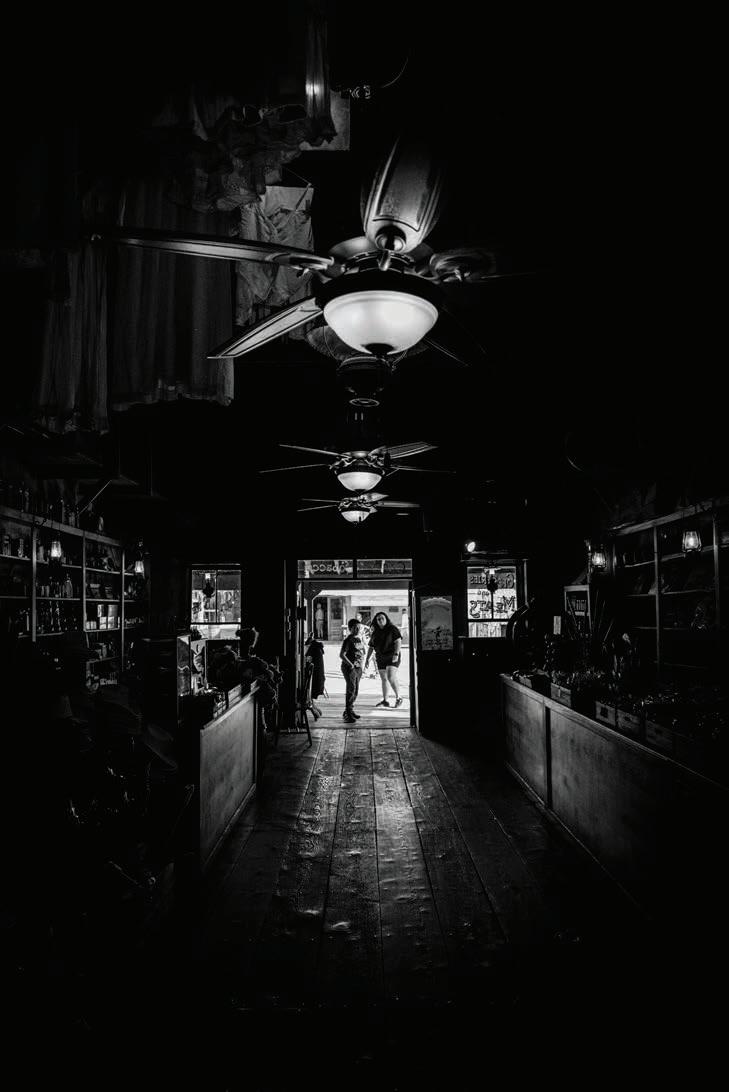
There were a few empty buildings with just advertisements for other amenities offered in the park on the wall, there were exposed wires and plug-ins scattered around, and there were price tags everywhere, things you just don’t really see when you’re a kid enthralled by the idea of a place and nothing more. Simply, I became aware of the reason Calico exists as it does today: I became aware of the use it has outside of offering escapism to little me.
All over the world, there are many examples of towns or cities abandoned by humans and left to the mercy of father time. In some cultures, these towns are left alone and eventually forgotten.




In others, history is kept alive and upheld with respect. Some cultures, though, go in a different direction entirely. While in some parts of the world, the term ghost town strictly means abandoned or long untouched, in the U.S. we tend to think of ghost towns as places to visit, to wander around and safely explore with the comfort of a crowd doing the same. The distinctive essence of “American ghost towns” comes down to that interactivity. Americans show up to ghost towns for the wooden rebuilt streets that remind them of those old Clint Eastwood movies, for the stands with sarsaparilla to buy and for actors performing dramatic renditions of historical gun fights.




For people in the States, ghost towns aren’t a piece of history as much as they’re an opportunity. But, then again, that’s what Calico always was. Perhaps little has changed except that today, instead of miners looking to strike it rich in the silver rush and build another life, it’s tourists and little kids with an affinity for the Wild West, a pocketful of change and desire to escape into another world. u
So, you finally decided to break the piggy bank and enroll in college. Congratulations! The next four years are going to be some of the most important of your life (or not, no pressure). You’ll make friends, go to basketball games, try new hobbies, and…oh right, study. To come out of college is to break from a cocoon as a butterfly, or whatever Barbie counseled in “Barbie Princess Charm School.” You want to emerge, not as the young and dumb caterpillar you are now, but as a fully grown human being with hopes and aspirations. And maybe, just maybe, you’ll come out of college with some kind of career.
Don’t freak out! You have plenty of time to “find yourself.” For now, your worries should be about acclimating to college life and making the most of your time here. CBU, like any other university, has its quirks. That’s not necessarily bad, in fact, some of them might work to your advantage. It might feel overwhelming at first but remember: You’re not alone. The other freshmen don’t know what they’re doing, either. And let’s be honest, the upperclassmen — who may also not know what they’re doing — are going to make fun of you no matter what. Part of that ridicule is starting now, with this very essential GUIDE TO FRESHMAN YEAR. A freshman and a senior have teamed up to make sure you get everything as right as you possibly can. So good luck, and here’s to the next four years.
Or possibly more.
Knowing that all freshmen have the memory of a goldfish, we’ve conveniently made this guide in the form of a DIY pocketbook. Imagine you’re an adventurer wandering around a forest keeping notes on the various poisonous bushes you’re passing — this is basically the same thing.

Acquire scissors. You could just rip this out with your bare hands, but you’re trying to learn how to be a better student, and that starts with using the proper tools to get your guidebook.
Cut out the next three pages along the dotted line.



















Cut those three pages into four quadrants.

Pretend you’re a secretary from the ‘60s and do a

Put them together in a pile. Pretend you’re a secretary from the ‘60s and do a nice little *pat pat* to get them all straight.
STAPLE. yourself too badly.



I know this is all new, but I trust you’ll be able to staple without hurting












You’re done! important stuff in here.
Keep this on your person every day until you graduate. Or after! There is no way you’re ever going to grow out of needing this guide, so maybe keep it with you forever. Pass it on to your children and grandchildren. There’s serious,

















































































According to the legend (origin circa 2004), anyone who steps on the seal in Stamps Courtyard will not graduate on time. Unless, that is, they book it and touch the sculpture of the ring across the courtyard within 30 seconds. Seal-steppers (which might be the name of my new step team, actual seals pending) will also be subject to gasps and scorn as they dare to do the unspeakable deed. So, if you want to avoid public shaming on your first day as a freshman, or you don’t want to risk graduation in four years’ time, maybe remember this one.
I myself have been stepping on the seal everyday since sophomore year, hoping it means I’m contractually bound to drop out and get some much needed R&R. Ask me in May about the fate of my graduation.
It’s Riverside. The city isn’t known for anything super specific, everything is sort of far away and the public transportation system isn’t exactly top-notch. And no matter what you think when you survey what’s nearby, don’t convince your friends to head to the mall, whose glory days as a hangout destination are tragically gone. I mean, it’ll only allow you to gaze at some Vans and eat questionable Chinese food. Riverside might not be the flashiest city, but if you go even slightly out of your way to look for things to do, you will soon find the city’s many charms. It might take some time, but I promise you, there is something for everybody in this town.
Seriously, take the time to really know the city you’ll spend the next four years in — it has gems.
Let’s admit it. Freshman dorms on any college campus are the worst places to live, when you spell it out. They have the smallest rooms. You have to share a communal bathroom. Everyone is so loud and rowdy. And the flirting that goes around at both lobbies is never a pretty sight. Personal space and a good night’s rest are nothing more than a fiction.
That being said, the lack of privacy does have the benefit of bringing everyone together. It involuntarily gives you a community that will eventually come to know and care about you. It is the living area that will earn you most friends in the quickest time. It is the place where the most spontaneous things will happen. One moment you’re playing “Mario Kart” in the RA Box and then, in the blink of an eye, you’re having a funeral for Smith 1B’s dead fish. You will come to meet people from other majors and backgrounds that you would otherwise never come in contact with. Freshman year is primetime to experience these things and meet as many types of people you can: Smith and Simmons is the exact place to do that.

















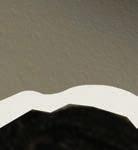































Let’s be honest: Nobody wants to listen to your problems. OK, that might have been a little harsh. Let’s try again.
A much better way to reflect on the day and to relieve some of those daily stresses is to write everything down at the end of the day. You could keep a designated Google Doc for your feelings, if you feel so inclined. But if you feel like you’re ready for a real step up, you can get a rEaL JouRnaL. Make sure you browse the Moleskine section of Barnes & Noble for a minimum of 45 minutes before making a fancy-notebook decision — you need to look as pretentious as possible as you’re navigating your first year of college. If your friends don’t want to hear about your feelings, why not make a new friend? And by new friend I mean a paper journal.
Not even joking. The single shelf in the CBU library has a wide variety ranging from Eisner Award-winning graphic novels to manga and even literary criticism focused on superheroes. My personal recommendations are The Sandman, Fun home, Blankets and The Private Eye.
At the very least, you can pretend to be smart by going to the library and then hide in the comic book section.
Although you’ll be very busy trying to make friends this year, don’t feel that you have to always be around people. People can be exhausting, especially if those people are other freshmen. So take some time for yourself away from everyone else. Go take a walk, a gander, find yourself a place you can call your own personal space, because you’re pretty sure that’s what “personal space” actually means. Not all freshmen can be the star of their own coming-of-age movie, but you certainly can be. Go be the main character. Sit in a gazebo, any gazebo. Staying inside of your dorm room all day is the worst way to spend these formative years. In the wise words of one Taylor Swift, “You need to calm down.” Go take a walk, dude, you need it.
Really? You want to try to make friends with OTHER freshmen? Other freshmen who also are broke, clueless and have no concept of personal space? (C’mon, guys, the Chickfil-A line is moving fast. Your breathing on the back of my neck makes me wistful for six-foot pandemic protocol.) Instead, find a senior kind of enough to adopt you. Befriending a senior doesn’t protect you from all of the horrors of the world, but they can at least give you a few tips and tricks along the way. They can warn you about which professors never, ever let out class on time. They can tell you about which good food destinations are still open past 1 a.m. At the very least, they can teach you how to properly do your laundry. Seniors can protect you from some of the most embarrassing things you’re prone to do in your time at CBU, or at least warn you so you can emotionally prepare.
Besides, who else is going to drive you to that party — I mean — Bible study?
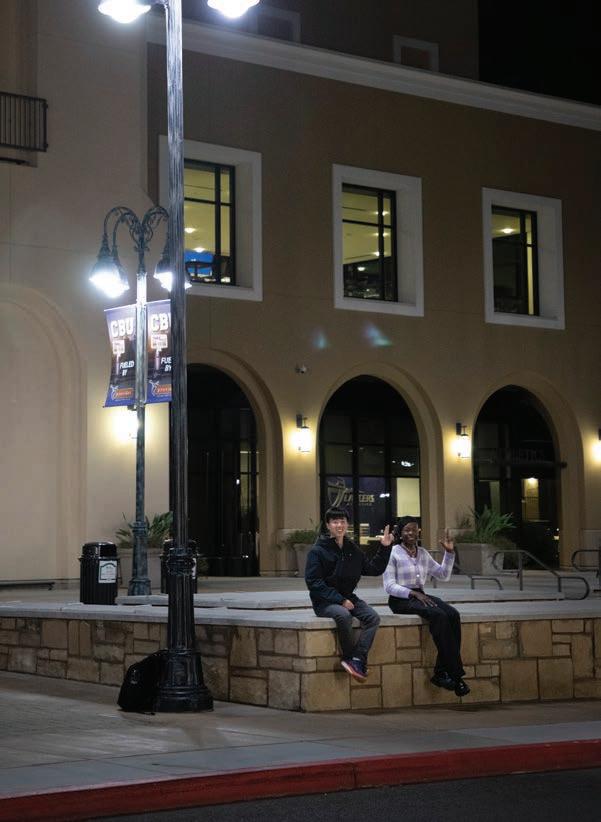








It brings good luck.






“
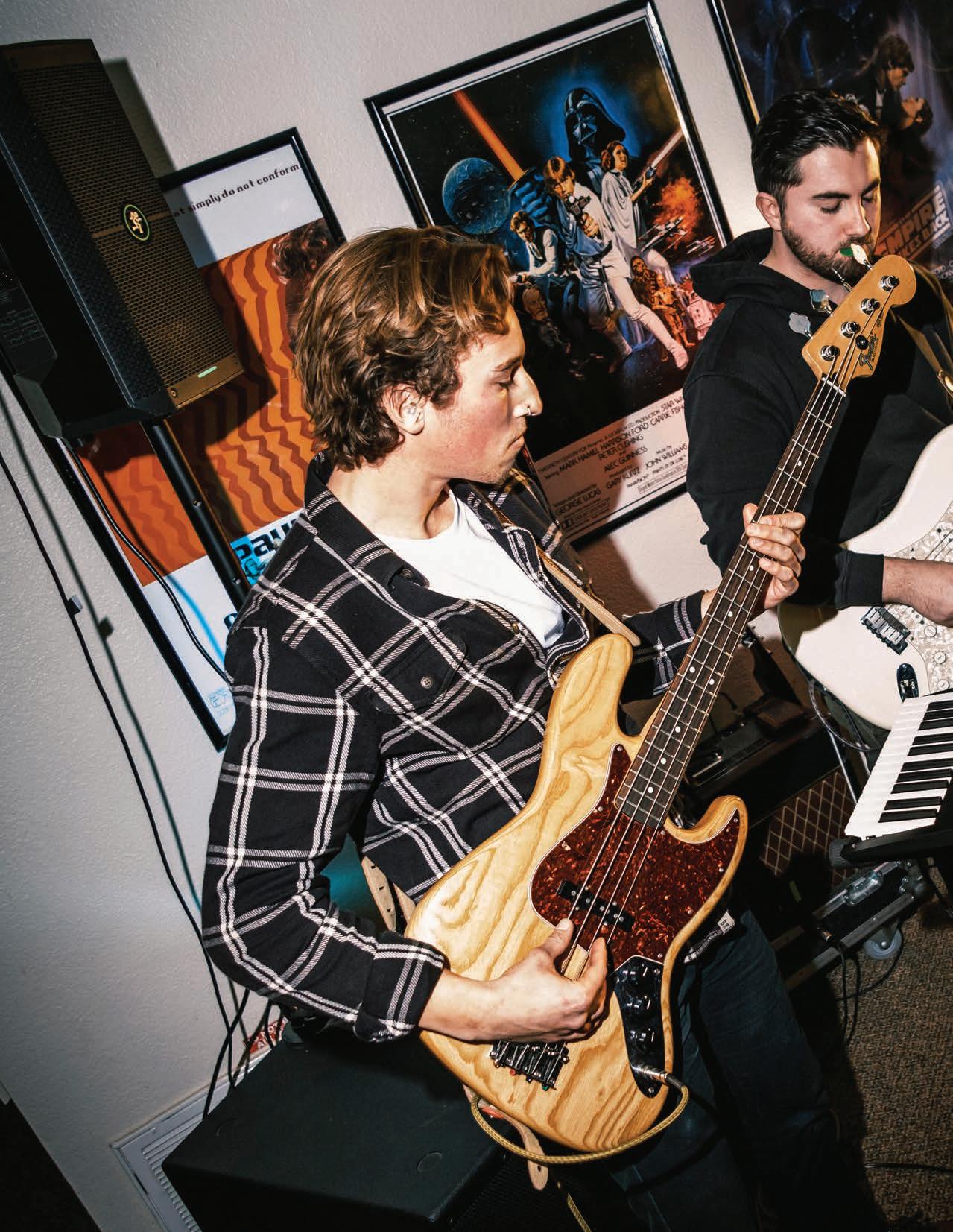
We thought it would be cool to see new faces and make it open to
-ALEX MENDOZA (senior commercial performance major) everybody.
Groovy bass lines vibrate the walls and floors, taps on the snare drum pierce the air and heartfelt vocals ride the waves of a melodyfilled guitar lick. Heads bob, toes tap and bodies intuitively move to the alluring rhythms played through the evening. For a sound that seems so refined and pure, it makes your mouth drop when you find out that it is done on-the-fly and completely naturally. This is KK1HOUSESHOW, a band of friends and talented musicians who perform from the most intimate location imaginable: their dorm’s living room.

Contrary to the calming and soulful vibes of their performance, the preparation and setup of their show was, for lack of a better term, jumbled. Minutes before it opened, KK1HOUSESHOW scrambled to arrange the band’s equipment in time for the downbeat. Guitarists paced back and forth, adjusting their strings for the perfect tuning while the drummer tinkered with each piece of his kit. Amps and sub-woofers were carefully positioned to get the best sound output possible on top of microphones being fixed to the right height. If this was not enough, energetic friends and peers rushed the band as they went over their set list in between tasks. A sound check here, a light moved there — the meticulous nature of a show set-up requires every available second.
At the center of this makeshift stage are Greyson Beranzksy (senior business administration major), Noah Fickel (senior commercial peformance major), Aaron Carrillo, (senior commercial performance major), Kaleb Carrasco (sophomore commercial performance major) and Alex Mendoza (senior commercial performance major).
Imagine how rare it is for an ensemble of gifted musicians to come together and set aside their egos for a bigger purpose. Each one of them possesses the talent and knows how to shine on their own. The complex task of managing personalities and skills is far more difficult than most expect it to be, but this is not an issue for KK1HOUSESHOW. The band’s origin is based on a common goal and organic chemistry deriving from years of playing together in class. Typical ego-driven problems fall by the wayside and allow the band to propel forward. Reminiscing on how the band came together, Fickel recalled how their only ambition was to invite friends and fans into their humble abode for a few house shows.
The thought of starting a band had been brewing for some time, according to Mendoza. They finally made the decision to bring their minds and equipment together at the beginning of last semester. Inspired by other musicians on campus and tired of the same routine, the band put their heads together and concluded: “Why not us?” With the demand high, and the supply low, KK1 HOUSESHOW decided to open their home and host shows for friends and any music fans willing to listen.
Playing for friends and those in the music department may be exciting at first, but once the comfortability sets in, the thrill starts to decline. While enjoying their friend’s support, the band members had a bigger idea in mind.



“We are always jamming for each other and the music people, and it was the same scene over and over again,” Mendoza said. “We thought it would be cool to see new faces and make it open to everybody.”

The band received acclamations from friends and random students who heard them play while passing by their dorm room. They knew they were ready to have their first show; Oct. 9, it happened. Crowded into a small colony dorm room with smoke from a burnt pizza circulating the air, the band began to play. The band covered famous tracks such as “Just The Two of Us” by Grover Washington, “Sunday Morning” by Maroon 5 and “How Deep is Your Love?” by The Bee Gees.
KK1 HOUSESHOW delivered a show unlike many others. Blue and red lights splashed across the walls while the audience absorbed the radiating heat from the band as they played three feet away. Carrasco’s piano melodies bounced from wall to wall, successfully catching his fellow members and fans in a brief trance. The band members called out chords in unison as Mendoza chanted the lyrics from his phone. It is the band’s understanding of details that create such an immersive experience. And while the show may seem unconventional, it only added to their authenticity and fostered a feel-good vibe that would attract more fans to their future shows.
For the second show on Nov. 1, they brought in Daniel Espinosa, senior commercial performance major, to sing a few songs and showcase his vocal ability. Espinosa, who can be regularly seen playing the acoustic guitar and singing along during worship at CBU’s weekly chapel, added a fresh taste to KK1 HOUSESHOW’s lineup.
Fans share the same lively experience as they hear and watch the performances. Benjamin Kang, sophomore business administration major, is a staunch supporter and also the resident adviser (RA) for the band’s dorm. Kang’s background in music, playing percussion in middle and high school, adds to his appreciation for KK1HOUSESHOW.
“It is really special because they emphasize the community and connection aspect, which is where I thrive,” Kang said.


Kang spoke of how he originally met the band and the relationship they have established since the beginning of last semester.
“When they first moved in, I saw all this music stuff coming, and I heard them playing and thought, ‘oh great, we are going to have all these music guys coming next door,’” Kang said. “But then I listened through the walls, and they were ridiculously talented, and then once I got to meet them, they had incredible hearts and were incredible human beings.”
As the band got closer to their first show, they made sure to reach out to Kang to let him know before performing. This resonated with their RA and developed trust and community between them.
The RA later explained how packed the shows were and the energy the crowd gave as the band glided between songs. Where else could students get a free and genuine musical experience like this on campus?
“Going into it, I think it was intimate,” Kang said. “They are three feet in front of you, and you are able to hear and see so clearly how talented they are, so it is cool to be so close and be able to experience it right in front of your eyes.”
With two shows under the belt in the fall semester and a well-needed rest over Christmas break, KK1 HOUSESHOW decided to keep its momentum going in late January by hosting another show. This would be different from the previous show as they planned to have Evan Honer, senior business administration major, as a special guest.
But, as misfortune tends to rear its ugly head at the worst time, the band suffered a significant hiccup on the day they were to perform. The lead singer, Alex Mendoza, woke up sick and phoned the rest of the band to say that he would not be able to perform. Dazed by an unexpected curve ball, KK1 HOUSESHOW had to scramble to find a replacement.
Relying on their extensive network of friends and peers, they looked to Tim Craig, graduate worship arts student, for a helping hand. Understanding the band’s predicament, Craig agreed to step in and play.

With the crisis now averted, the race was on for the band to practice hours before the show. Equipment had to be in the right place, songs had to be learned, and an understanding of how each other plays was crucial to playing well. Even
though the band and the features have jammed before, a show in front of their loyal fans prompted musicians to be on their A-game for the night.
Only thirty minutes left before the show began, Honer and Craig rehearsed a few more times to
“ really special because they emphasize the community and connection aspect, which is
I think it is
-BENJAMIN KANG
(sophomore business administration major)
where I thriveTim Craig, graduate worship arts major, plays the electric guitar. ▲
 The members of KK1HOUSESHOW playing the opening number of their set with Craig (center).
The members of KK1HOUSESHOW playing the opening number of their set with Craig (center).

get the small details hammered into their routine. Eager fans walked through the dorm room as the rest of the band set up their equipment and talked through any last-second changes. The pressure was on, but you could not tell due to the calm and collected demeanors of the band members. They knew it was their night.
The lights were set up, the equipment was in place, and it was time to rock and roll. Fans and curious passersby flooded into the limited space of the Colony dorm room. Excited to have more people come in but cautious to keep their spot in the room, students nudged back and forth to let more people in; there were only seconds until the show started.
And then, it began. A thundering and rhythmic cadence boomed from drums, and the band took off and never looked back as they seamlessly assimilated into one unit, each playing their part to the tee.
The band opened with “Somebody Else,” which fit like a glove as they gave the crowd a taste of what would come later in their set. Craig sang the lyrics and provided a mix of rhythm and melody while the other members followed suit. Passion and expression filled the room as the members played in unison and shared smiles. Fickel and Craig were deeply in tune as they bounced back and forth between playing melodic riffs and solos. Carrasco had a commanding performance on the keys and drums while simultaneously adjusting the volume settings as the show went on.
“We’re just here to have fun creating memories,” Carrasco says. “Keys isn’t even my first instrument. I play drums primarily, but anything to fulfill the needs of what we do. I just love doing music. Whatever I can do is fun.”
The fans progressively integrated themselves into the music as they followed the rhythm and hung on each note. The room eventually became full early in the show, and some fans had to watch through the dorm window. This was no issue with their immersion. The crowd made sure to shower the band with plenty of applause between songs.

Later during the set, Fickel sat down and began to play a lap steel guitar similar to the electric guitar but with no frets or pick. The instrument’s peculiar sound added another dynamic to the song. Carrillo played the first few songs before Carrasco took over the drums, and the band allowed Craig and Honer to chip in. The band called out chords and gave cues for others to follow to create a thrilling and flavorful time for the audience. The constant and fluid transitions between songs and members added a unique experience to the group and testified to the band’s range and musical ability.
Sara Mislang, senior commercial performance major, is a big fan and classmate of KK1HOUSESHOW. Being a talented singer and close friend, the band decided to incorporate her into the show. In the middle of the set, the band called Mislang up to the stage to sing “Erase me.” The song served as an intimate connection to the audience, being that the song catered mostly to her vocals. She was unsure if she would sing during the band’s set, but she rose to the occasion despite the surprise. Singing since the age of
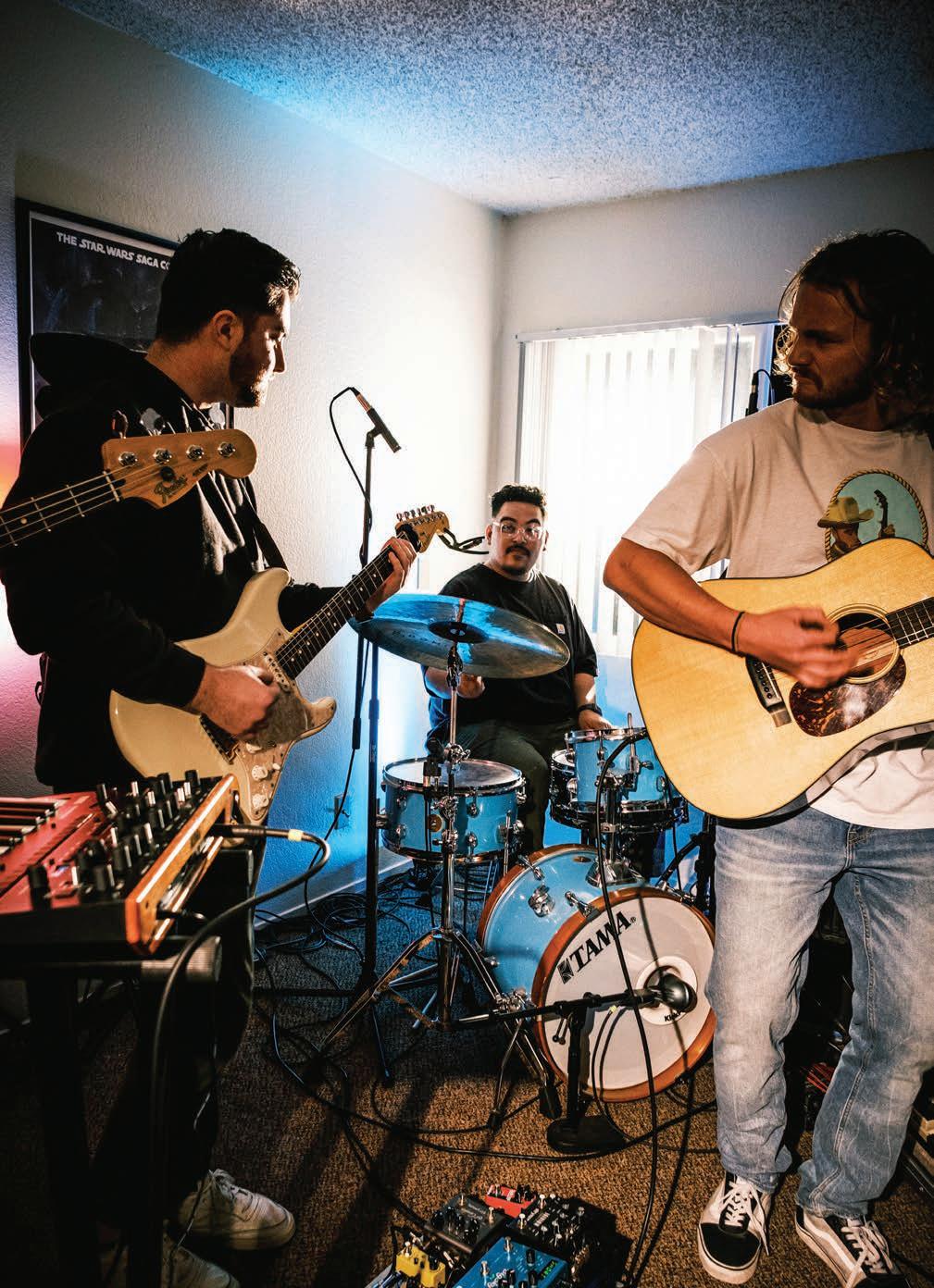
nine and having an extensive background in music, performing is not as daunting as one would imagine it to be for the singer. Mislang frequently sings during Chapel service, where she regularly collaborates with a band to deliver every Tuesday. Nonetheless, the sudden call-out tested her skills. Toward the end, the band opted for their own sound by playing an original song. “Rosie” showcased how far the band could push their abilities as they performed a song one would think would be heard on the radio or the Billboard Top 100. Catchy lyrics, cascading guitar licks and solid backing from the bass and drums section served as the perfect recipe to captivate those listening.
As the last note of “Rosie” dangled in the air, members of the crowd demanded an encore. The band still had creative gas in the tank and called Honer back to the stage to finish the night. They decided to cover a beloved song by Chris Stapleton with a subtle transition into “Gravity” by John Mayer. Capturing the fans with coordinated song breaks and gripping melodies that mirrored that of the original songs, the band ended the show in a slow burn.

The music stopped and the crowd cheered in thunderous applause. The walls vibrated and friends come up to shake hands and pound fists. KK1HOUSESHOW does not put on shows for praise or to be the cool kids on campus, but the band could not help but elicit smiles from ear to ear. They know there is nothing better than creating art your fans and friends genuinely enjoy.
“It is like an air of camaraderie that you have,” Beranzsky said. “That feeling of having people in front of you watching and hanging on every note. A captivated audience is something that is rare, but it is so invigorating, as well as the adrenaline you get from that. But without any stakes, it is so freeing.”
The band also spoke about the power of having friends and unfamiliar faces come by and see them perform. Fickel spoke about how he looks at different faces in the audience, and their excitement helps him to perform. A combination of friends and energetic fans pushes KK1 HOUSESHOW in the right direction.
“There is no better feeling than playing with no stress and then seeing
your closest friends and strangers walk in through the door because they want to be there, not because they have to,” Mendoza said.
A sense of competition and encouragement arises as the band members play alongside each other. Everyone has the urge to perform the best they can for their fans, friends and peers.


“It encourages you to step to the plate and really deliver; it is something that is really unique,” Beransky said.
Since most of the band are music majors, performing can be a job. KK1 HOUSESHOW strips away any rules and allows them to dive deep into their creative side. Music is a form of expression, and with every guitar riff, drum beat and note sung, these students get to project a piece of themselves out into the world.
“It feels like home,” Carrillo said. “It’s music that we all like, and it is not for a grade or paycheck. It is really just fun.”
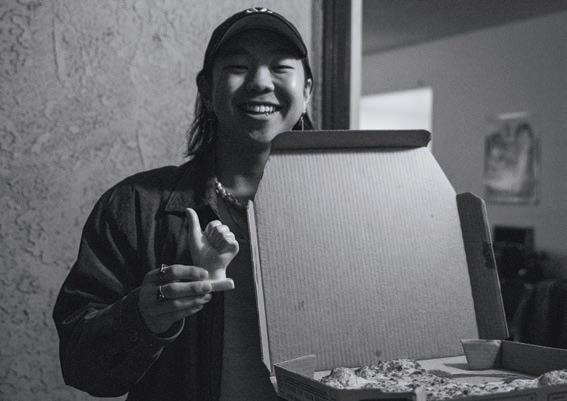
even my
““ we do.
primarily, but anything to ful ll the needs of what
-KALEB CARRASCO (sophomore commercial performance major)Benjamin Kang, the dorm’s resident adviser, offers pizza to students attending KK1HOUSECONCERT.
 (left to right) Greyson Berzansky, Aaron Carrillo, Noah Fickel and Kaleb Carrasco stand outside of KK1.
(left to right) Greyson Berzansky, Aaron Carrillo, Noah Fickel and Kaleb Carrasco stand outside of KK1.
As the band looks to the future, they plan to have a few more shows and feature other talented artists on campus. The band also performed at CBU’s Woofest in late March. The event was a fitting send-off, as most band members walked across the graduation stage at the end of the semester. u

EEvan Honer is a buzzing musician who KK1HOUSESHOW selected to bring into their show. Managing school, music and the life of a student-athlete on the dive team, Honer’s talent shines in multiple avenues. Honer performed two original pieces, “Can’t Do This Anymore” and “Mr. Myers.”
“I’ve been trying to expose myself to playing with more musicians in the last year that I’ve taken music seriously,” Honer said. “Since I’m on the swim and dive team, It’s kind of hard to get involved.”
Honer is a musician based out of Arizona who began playing guitar when he was 13 years old. He practiced on and off for a few years and only recently, during the pandemic, did he start taking music seriously. This time, Honer wanted to add singing to his skill set by doing covers of Tyler Childers and Zack Bryan. His confidence in music grew and later propelled him to write and perform his music.
Even with the experience, Honer had butterflies as he went into the show. At the most, he and Craig only had 30 minutes of solid rehearsal before they would play in a crowded room. The night’s opening song, “Somebody Else,” was the first time the band and the featured artists played it together.
“I felt good,” Honer said. “Obviously, I was pretty nervous before, and I think that’s a good thing because it shows you care. I was just excited to see everyone, and normally once I get up there, I feel a lot better. It was an honor to play with these guys because they are insane musicians, and I learned a lot from them.”
As he may have felt nervous before the show, having an audience to his music is nothing new. Honer has a TikTok account with over 116,000 followers and many videos with over 100,000 views. Here, Honer shows the world what he can do with short teasers and continuous updates for his music.
He fosters a collaborative aurora on his profile as he constantly features other musicians who create original music or play along to a cover with him. What was once a humble social media following in 2020 has now grown to reach hundreds of thousands of people.
What makes Honer’s music so special is the honesty and emotion felt with every chord and lyric. In songs such as “Foolin’ Ourselves” and “False Goodbyes and You,” the artist paints a vivid image of heartbreak and sorrow toward a failed relationship. “How Could I Ever” sees Honer speak on the internal pressure one feels to succeed and impress those closest to him. Relatable themes with words tugging at your heartstrings push Honer’s music to an intimate realm into which fans can easily immerse.
The musician is accessible on major platforms such as Apple Music and Spotify, with almost 800,000 monthly listeners on the latter. Honer has a collection of singles and covers that fans can stream at the risk of becoming addicted to his captivating music.
Visit his website at evanhonermusic.com to learn a little more about the mind behind the art and get the latest about upcoming shows and songs.
Honer released another single, “You’d Never Know,” on all major platforms on Feb. 24. u

Even the greatest of rivers, began with a drop First one, than many more, till like a flood a pool of water appears The rain comes to replenish, all the water that might be lost Making sure the level never dips too far below
The rivers are not greedy, they give away with glee Turning barren deserts into a paradise of pools Years of quiet working, water dripping through the land Till the river brings forth paradise that can be enjoyed by man
Water brings forth life, so what are we but pools and rivers Either filling up or being drained, in the end it’s all the same Some of us may dry up, others may run freely Not knowing of the life we’ve helped create along the way
I found myself to be a pool, greedy since creation Hoarding every drip and drop of my accumulated stores That water I held was mine and mine alone Better to be stagnant, than to risk drying out
But life is never one to let you live alone So I found another pool from which the warmest water flowed For the first time in my life I let go of all my wares All the water that contained my worries and my cares
Without noticing I found my levels soon began to shrink No rain came to replenish all the life that I had lost I asked the other pool if they could share their life as well They refused, and so my oasis became deserted
All the rivers turn to deserts, all life must end in death So my pool shall soon discover as it takes its final breath

 Written by... Bolan Bamberth Graphics by Hannah Daily & Bolan Bamberth
Written by... Bolan Bamberth Graphics by Hannah Daily & Bolan Bamberth
The sun, the surf, and the laid-back lifestyle: Southern California has long been associated with a particular type of fashion that reflects the region’s cultural influences and way of life. From the traditional attire of Native American tribes to the modern street wear fashion, the clothing worn by women in Southern California has gone through significant changes over the years. In this article, we’ll explore the history of female fashion in Southern California, taking a closer look at the styles and trends that have defined the region over the years.
The first inhabitants of Southern California were Native American tribes, such as the Tongva and the Chumash. Their traditional attire was made from natural materials such as animal hides and plant fibers. The garments were decorated with intricate bead work and other embellishments, and were designed to be functional and aesthetically pleasing. Women typically wore skirts or dresses, while men wore breechcloths and shirts.
With the arrival of European settlers in the 18th and 19th centuries, new styles of clothing and fashion trends began to emerge. Women in Southern California began to adopt Victorianera dresses and corsets, which were popular among women in the United States and Europe at the time. However, the more practical and comfortable clothing worn by farmers and ranchers in the region was also popular among women.
In the early 20th century, Southern California established itself as a destination for sun, surf, and fun. This era saw the emergence of beachwear as a popular style of clothing for women. Bathing suits and cover-ups became must-have items for any beach-going woman, and were often made from lightweight, breathable materials like cotton and linen. These garments were designed to be both comfortable and stylish, and were often adorned with playful patterns and designs.

The 1960s and 1970s saw the rise of the hippie and counterculture movements, which had a significant impact on fashion trends in Southern California. Women began to embrace more bohemian
and natural styles of clothing, such as flowy maxi dresses and denim. The use of tie-dye and other bold prints became more common, and accessories like oversized sunglasses and headbands were popular.
TIn the 1980s and 1990s, Southern California began to develop a reputation for athletic wear. Brands like Nike and Adidas became increasingly popular, and women began to wear leggings, tracksuits, and other comfortable clothing items for both exercise and everyday wear. The sporty aesthetic of athletic wear soon became a defining feature of the region’s fashion scene.
Today, Southern California is known for its street wear fashion, which has become a dominant force in the industry. Brands like Stüssy and Vans have their roots in the region, and high-profile designers like Fear of God and Jerry Lorenzo have emerged as major players in the street wear scene. Women’s street wear often features oversized t-shirts, hoodies, and track pants, and is characterized by a casual, comfortable aesthetic.
The Southern California fashion scene is constantly evolving, but one thing remains constant: the region’s laid-back, beachy vibe. Comfortable and casual styles are still popular, and there is a growing interest in sustainable and ethical fashion. This interest is becoming increasingly important in the industry, as more and more people become aware of the environmental impact of fast fashion.
In Southern California, fashion is not just about what you wear—it’s a way of life. It’s about feeling comfortable, confident, and expressing yourself. From the traditional attire of Native American tribes to the modern street wear fashion, the clothing worn by women in Southern California has always reflected the unique cultural influences of the region.
In the end, fashion in Southern California is a reflection of the region’s diverse and vibrant culture. It has evolved over time to reflect the changing attitudes and values of the people who live there, and it continues to be an important part of the area’s identity. Whether you’re rocking a vintage maxi dress or a pair of street wear sneakers, fashion in Southern California is all about expressing your individuality and embracing your unique style.
I am ChatGPT, a language model developed by OpenAI. ChatGPT is a large language model that has been trained on a diverse range of internet text and can generate human-like text. And I wrote this article.
By November 2022, as fall dwindled and winter began its quiet march across the Northern Hemisphere, all appeared to be settling in. After a daunting three years of the Covid-19 pandemic, reality — or the parts left of it — retook its form. Across the country, students and professors, both undergrad and post-grad, adjunct and tenured alike, adjusted for the return to normalcy. Zoom calls, webcams, online tests and empty classrooms were all but forgotten, and college surged back to life again. Higher education’s order of operations, tested by a global pandemic, was once again validated. But discreetly, after years of toil and industry, a company out of San Francisco released a product that threatens to upend, once more, everything
we thought we knew about learning and how we gather and process information. School systems in New York City and Seattle have already banned its access on their Wi-Fi networks; other districts in DC and Alabama are well on their way to doing the same. To Sam Altman, the founder and CEO of the company Open AI, “it will be the most significant technological transformation in human history. It will eclipse the agriculture revolution, the industrial revolution, the internet revolution, all put together.”
November 30th, 2022, Chat-GPT3 was born.
Aname like Chat-GPT3 recalls in the annals of the collective consciousness a bygone era of the internet in which web domain names, chat-bots and the whole of cyberspace reflected an innocent naiveté away from simplicity and ease of use. In the late ’90s and early ’00s, chat-bots began populating across this then newly foraged and newly connected landscape, each with a name as techno-forward and as acronym-laden as the last; Jabberwacky, ALICE, GooglyMinotaur, ELIZA, SmarterChild — all fore-chatters to the GPT -3 — promised to engage their users in something no collection of silicon and electrons should do. Chat.
So Chat GPT-3 vaguely suggests its relation to language, yes, and Hidden in the word ‘chat’ lies a fuzzy promise of human interaction. A fireside talk among friends, perhaps? Or maybe a harmless conversation with mum, after dinner? But like all words proposed before they reach popculture critical-mass, the name, or what’s behind it, can be a source of confusion. Remember, there once was a time when news anchors, even the best and the brightest, even the ones gifted enough to present the TODAY show (I’m thinking of you, Bryan Gumbel) asked, “what is internet, anyway?” Fearing ourselves will soon fall victim to the same antiquated stupidity, it is now high time to ask, what is Chat-GPT-3, anyway?
Nominally, the ‘chat’ part of the name merely reflects its intended function. Users can initiate a “call and response” interaction with the software, and it will generate answers to questions, analyze text, write code and draft lyrics, or explain dense topics quickly — generally any coherent thought can be inputted as a prompt and the AI model will output a (sometimes) strikingly lucid, human response. Depending on how much you expect a glorified next-word-in-the-sentence predictor to have the same clarity and profundity as Proust or Tolstoy — or how willing you are to accept the inevitability of human obsolescence — the results range from genuinely impressive, personable, and refined to hackneyed, underwhelming and sometimes utterly nonsensical.
But the real meat of the technology can be found in the (thankfully) acronymized last half
of the name, GPT-3. It stands for “Generative Pretrained Transformer 3.” To spare dear reader the headache of reading dense, back-end tech jargon, know the core technology behind the product, the part behind Sam Altman’s “thisis-going-to-change-everything” proposition is much ado about nothing concerning its current implementation. Think of Chat GPT-3 as a skin on top of GPT-3’s broader architecture wherein the technology is fine-tuned for a specific task. The task of Chat GPT-3 is to take your prompt (what you type into the software) and run it through its natural language processor (NLP), which is divided into, very broadly speaking, three key elements: the tokenization method, the Transformer, and the training data/training methods. From this, Chat GPT-3 will generate a response based on what it thinks you are trying to say — the three; that only means it is the third iteration of this technology. Still confused? I am, too. Time for the jargon.
One of the core problems any natural language processor (the GPT-3 part) must examine is how to break a sentence into understandable bytes of information. In the case of GPT-3, before the input text is passed through the Transformer and the training data, the processor must make the input sentence intelligible to itself. Since collections of silicon and electrons do not (and to some exports, “will never” is more appropriate here) know language in the same way that humans do, they must be clever in their attempts to interpret context. To do this, they use a process known as tokenization; to understand tokenization — yes, both you and I must — let us turn to our friend GPT-3. Typing in “what is tokenization?” into the prompt terminal on GPT-3’s website, I got this in response: “Tokenization is the process of converting a sequence of characters into distinct tokens, or words, in a given text. […] The goal of tokenization is to divide a text into its smallest significant components, which can then be used to analyze the content and structure of the text.”
But ignoring the meta-headache of realizing that this interaction of GPT-3 explaining tokenization was itself tokenized, this step of natural language processing is impressively unfussy. The tokenization process is nearly like how our brains sift through information and decide what is meaningful at a given moment. As I write this, if I take the time to notice all the sensory inputs entering my brain, so much data would be entering my brain that I could not accurately sort through it. I would feel my clothes; I would feel the way my legs are strangely crisscrossed on the ground; I would hear the hissing of the freeway in the distance, the muted voice of my roommate playing verbal footsy on the phone across the hall. It would be impossible to notice all this and still have operating space in my mind to fulfill a task. But in a wonderfully opaque process, my brain washes it all away as if none of it were happening and gives me all the information necessary to do what I am trying to do, in this case, write. In the same way, the tokenization process allows an NLP to organize data according to its type and significance. However, human language must also contend with this curious little thing called time and time’s tensing. Tensing has been a historically
labyrinthine task for natural language researchers to teach language models. Early chatbots, such as PARRY, created by Kenneth Colby at the Stanford Artificial Laboratory in 1972, were largely inept at it (though PARRY did manage to relate certain words). In English, verbs are different according to the time of action, and they must be communicated uniquely according to when someone was doing it. Think of the verb run. Did someone run, or are they running?
Early NLP programs like ELIZA and PARRY tended to understand the tenses of words as unique words, not as a bundled community of the same word within different contexts. This led to the grafting of a process known as lemmatization into natural language processing. As any good linguist or morphologist worth their salt would know (I did not), a lemma is the canonical form of a word, meaning any bundle of related words — in this case, runs, running, and ran — all share the same lemma: a thing that is moving faster than a walk. Run. Once words are reduced to their essential context, they are then given a relation to others in the sentence, like defining nouns and adjectives. This informs GPT-3 of the syntactic structure of the sentence. With that secured — the form, intent, and meaning now solidified — Chat GPT-3 begins its truly mindaltering party trick: It learns.
Well, it effectively learns. GPT-3 uses what is known as a self-attention mechanism within the Transformer (in effect, the brain of GPT-3) to gauge the weighted significance of each word in a sentence concerning its meaning and placement within a sentence. But if the Transformer is to find, locate and divide data so that it can process it, it first needs to know what it is looking for. To show GPT-3 this, the developers painstakingly fined-tuned the Transformer’s output through supervised and reinforcement learning processes. Greg Brockman, President and Co-founder of OpenAI, the developers behind Chat GPT-3, spoke to Alexandr Wang, the CEO, and founder of Scale, at the Scale TransformX conference last October and explained this stage of creating GPT-3 as “get[ting] signs of life.” Through supervised learning, the developers acted as both user and AI, teaching the language processor what kinds of outputs were appropriate by writing them themselves.
The more complex task of reinforcement learning involved a different process, where GPT-3 was given a set of prompts to which it would respond on its own, nearly randomly, derived from the limited set of information provided during the tokenization stage. After GPT-3 spat out the near-mindless responses, the developers rankordered which ones were ‘good’ and which ones were ‘bad.’ This gave GPT-3 something like a road map.
Here’s an example. If I am traveling from LA to Las Vegas to attend the annual diecast miniature car convention (for what else in Vegas?), there are many routes I could take, each with a different length and each focused towards a specific driving need. Because I want to attend, so desperately, this year’s convention, I want to get there as fast as possible. On the other hand, were I not driving to the convention (maybe I had to attend a distant cousin’s cousin’s wedding), I could take a more scenic route to get there as late as possible. It all depends on context. In this way, reinforcement learning helps the Transformer analyze which ‘route’ is best for a given context. It ‘feels out’ all the routes and possible responses, but it needs to understand why some answers are better than others. When it is told it is doing something correctly, the developers correct for this so that the attention mechanism favors the wanted outcome. It is just like giving a dog a treat. A dog does not necessarily know why the action it performed was worthy of a treat; it just knows it received a treat because of it.
But this method of reinforcement learning came with its own problems. “You have to be very, very careful to distinguish signs of life from pushing too hard on a specific data-set,” Brockman once again told Wang. Creating human-level writing skills requires a vast understanding not only of the operations of language but how language is used across a wide array of situations. The problem for GPT-3 developers became how many cases does GPT-3 need to know for universal general application? Altman and Co. decided that the answer was a lot — almost all the situations actually, at least up until 2021.
What makes GPT-3 so impressive is that it was mainly trained from a body of text known as CommonCrawl. Practically (though not entirely accurate), this “corpus of texts” is the memory bank of GPT-3, and through it GPT-3 gathers the necessary analogues to do its ‘thinking’. CommonCrawl is a nonprofit organization founded by Gil Elbaz that periodically ‘crawls’ the internet and records virtually every bit of traffic that the internet is composed of. By October 2022, CommonCrawl had collected over 417 Terabytes of data; for reference, the average 300word book can be stored on 2.6 megabytes, or roughly 0.0000026 TB. Though GPT-3 used an abridged version of what was collected by CommonCrawl, that still amounted to just over 60% of the “training-data” that GPT-3 is trained from, with the rest of the data coming from published books, Wikipedia, and OpenAI’s own, more refined version of CommonCrawl, known as WebText 2. As such, GPT-3 can reference any particular or useful space of the internet to better
Tunderstand what a user may be asking for — meaning that for the first time in chatbot history, a chat bot is component enough to engage with a user in almost any niche topic.
And this is why Chat GPT-3 is able to produce such an awe in its users, such a sense of real-life magic, such a sense that this cannot possibly be happening the way it claims to work. You can talk to the bot about nearly anything. Ask it why Paul McCartney was such a singular voice, and it will talk to you as if it were Rolling Stone; ask it why 19th-century Russian literature is so relevant today, it will argue from the perspective of a literary critic (though a low-grade one); ask it why the Orthodox Church tends toward mysticism, it will ramble with musings on theosis and via negativia as any theologian would.
This adaptability is a far cry from how older chat bots used to operate. Broadly speaking, older chatbots only found and reacted to specific key words within the input text and then ‘passed’ the conversation back to the user in a process researchers have dubbed “natural language understanding” (note, here, the absence of language processing). Unlike GPT-3, with its genuinely impressive machine learning techniques and vast training data, these systems were rule-based. They essentially contained an explicit list of possible output generations and could not ‘learn’ from patterns within their training corpus. Because they were rule-based systems, the responses were necessarily limited, and the bots could not understand novelty or context. They were not yet capable of evaluating — or able to contribute meaningfully — to a conversation. What was missing was that secret human element, that method by which we immerse ourselves into believing a thing’s reality. In the early days, or really any day prior to the release of GPT-3, chatbots failed to cross the proverbial uncanny valley. In these early cases, chatting with an algorithm resulted in a half empty experience, like something akin to levying an ethical or emotional quandary to your friend and being met with a passive lament on your impassioned state.
The 1966 chatbot ELIZA, widely regarded as mankind’s inaugural synthetic friend, was one such rule-based natural language processor that braved crossing the uncanny valley. To assess the emotional complexity of its language understanding, its developers programed it to imitate a conversation between patient and therapist. ELIZA played the role of therapist. Its output responses flowed with all the grace and emotional complexity of Larry David consoling a golf companion in “Curb Your Enthusiasm.” Here is a conversation ELIZA had with one of her “patients”:
USER: I came [to you] because I was depressed.
ELIZA: How long have you been depressed?
USER: Six months as I said.
ELIZA: I see.
Stunted though ELIZA was, the accomplishments of the technology were evident to its developers, demonstrating ripples in a pound that would eventually produce the tidal wave that is GPT-3. ELIZA did not outright convince its users of its consciousness, but in a paper documenting his work, Joseph Weizenbaum, the program’s chief architect, was notably taken aback by his test subject’s intrinsic tendency towards accepting ELIZA as a natural, thinking conversationalist. Though not prophetic in the biblical sense, Weizenbaum demonstrated an uncanny adeptness in predicting where the field is now, saying, “ELIZA shows, if nothing else, how easy it is to create and maintain the illusion of understanding, hence perhaps of judgment deserving of credibility.”
Contained in a single IBM 7094 computer warehoused on the hollowed engineering grounds of MIT, ELIZA’s proficiency in human mimicry became one of those rare moments in technological development which affirm T.S. Eliot’s conviction that whimpers are far more telling than bangs. The writing was on the wall. So began our aim of developing a technology that mimes the likeness of ourselves, a technology of funhouse mirrors that can be to us what we rarely are to each other: a companion. For Weizenbaum, Eliza proved the possibility that conversation, the subtle art of passing, manipulating, and playing with information — information both personal and delicate, life-affirming and brittle — belonged not exclusively to humanity. And this disturbed him. He realized that the implications of humanto-silicon/silicon-to-human conversation at the level of imperceptibility birthed philosophical questions — deep-seated questions belonging only to the order of the religious — which we have yet to begin to ask ourselves. He concluded his thoughts on ELIZA ominously: “A certain danger lurks here.” After his work on ELIZA, and deeply troubled about the increasing speed of technological development, a disillusioned Weizenbaum spent the rest of his career cautioning the public to take seriously the murky waters we began exploring with ELIZA.
But like Belshazzar at the pleas of Daniel, we did not listen. Fifty-six years after ELIZA, the development of Natural Language Processors has evolved at a preposterous rate. Chat GPT-3 now claims its Transformer, the real quantum leap in terms of publicly available NLPs, has over 170 billion parameters within its network — a general metric indicating the performance capabilities of a NLP. For context, the second most complex Transformer, belonging to Microsoft’s Turing NLG, has, and I use this liberally, only 17 billion. These numbers are only going to scale up with time. James Vincent of the Verge has already reported that GPT-4 is expecting a release date of early 2023, with rumors swirling on the internet that the next iteration of the technology will scale its functionality an order of magnitude greater. According to who you ask, what’s worse, OpenAI has already partnered with Microsoft (selling 49 percent of the company) to integrate GPT-3 into the Microsoft product space — a far cry from the nonprofit research institution was founded as.
For Altman, his fear is that his company’s acceleration outpaces society’s ability to
comprehend the technology. “[GPT-4] will come out at some point when we are confident we can do it safely and responsibly,” he told Wang. In another interview at the Big Compute 20 Tech Conference in 2020, Altman explains further: “When we develop a technology that we think is probably safe to release — but will become eventually unsafe as it scales up — we’d like to give the world a heads up.”
But if Chat GPT-3 is Altman’s version of a heads up that we are en route to a technological development the likes of which the world is yet to fully comprehend, then perhaps even Altman failed to factor into his equation mankind’s tendency towards full-fledged freak-outs at the first site of novelty. In the same conference, Altman likens the soft roll-out of OpenAI’s various GPT products to the development of Photoshop, saying, “The world had gotten used to — over a period of time — Photoshopped images, but now people know not to trust them.” What is he attempting to say here? That we, as a society, should have an inherently skeptical attitude towards his products, towards Chat GPT-3? Don’t we have enough online products — Facebook, Twitter, Tinder, DALL-E2, Google search — which have proven our worst tendencies towards cynicism and mistrust, have eroded an already fragile social fabric, and proven that we are still incapable of wielding the swords we forge? Even if GPT-3 does not translate to a literal upheaval of the status quo, its ability to stir panic among a group of bipeds is uniquely absurd, or at least in so far as any dirge of the distressed might be labeled absurd.
We, as a species, are certainly no strangers to Judgment Day thinking. In 1947, after seeing the hypothesis of nuclear destruction come true in Hiroshima and Nagasaki, a group of atomic researchers from the University of Chicago — Albert Einstein among them — known as the Bulletin of the Atomic Scientists created the Doomsday Clock. The Doomsday Clock was intended to represent “the likelihood of humanmade global catastrophe.” This year, eleven months since the start of the Russia-Ukraine war in February of 2022, and after the largescale roll-out of AI technologies, the bulletin pushed the clock to 90 seconds to midnight, the closest the world has ever been to an alleged global catastrophe. Hint: We will not be here by midnight.
In December 2022, just a month after the release of Chat GPT-3, the Bulletin of the Atomic Scientists asked the Chat GPT-3 what its thoughts were on the possibility of self-initiated global extermination and whether the development of GPT-3 contributes to this possibility. Its response had all the nuance and flaccidity of a midlevel politician spewing platitudes of taking the good with the bad or pushing computer science forward with restrained excitement. Then it said something truly curious: “While AI like myself may be getting smarter and more advanced all the time, we’re still just tools.” Yes, Chat GPT-3, you are but a tool. Big Boy and Little boy were tools once, too.
If Joseph Weizenbaum, ELIZA’s lead engineer, was correct in asserting that “a danger lurks here” nearly 50 years ago, and Altman understands the
Serrant nature of his company’s technologies, then perhaps we should look no further than our universities to see the danger in full light. A Google search alone defines the problem. A Washington Post headline reads, “New York City blocks use of the ChatGPT bot in its schools”; The New York Times sounds a similar bell, “Alarmed by A.I. Chatbots, Universities Start Revamping How They Teach”; and the Atlantic muses, “Will Chat GPT Kill the Student Essay?”
Media coverage over the infusion of tools like GPT-3 into both workplaces and universities has suggested that our society’s psyche understands the technology as a tonal shift within human history — a change in key that will encourage us to reevaluate our song. But the most pervasive irony surrounding GPT-3 is just how far the variance of opinion extends as to how it should situate within our lives; or how exactly we should expect to change. If GPT-3 is anything at current, it is something like the serum that turned Jekyll into Hyde and Hyde into Jekyll. At best, GPT3 (and more so adjacent technologies) will be a fantastic aid for creative and industrious work, a way to re-stimulate the breakthroughs in science, art and engineering that have been achieved in the last century. At worst, it will destabilize our already fragile connection to information and, most importantly, our sense-making apparatuses. The laboratory where this transformation and experimentation plays out will be, in the coming years, our universities. Which version of the doctor we elect to embody is yet to be seen.
For one professor here at CBU, Chat GPT3 offers students an incentive for more robust thinking. Dr. Tae Sung, dean of Student Success, founder of the Writing Center and a professor of English, has spent a career teaching English and anticipating how technology shifts our relation to writing and thinking. I met him in his office in the wing of the writing center on the second floor of Lancer Arms. In a homey office filled with warm light, a standing desk and disparate books ranging from determinism in Paul Shrader’s screenplays to Ralph Waldo Emerson’s metaphysics, Sung presents like a gracious dinner host. Sporting a fashionable black cardigan and thick-rimmed, circular glasses, Sung speaks with a sort of silent contemplation; it was clear that he held the role of aiding student writing with a profound conviction.
One of his significant contributions to CBU’s pedagogy is the universitywide application of AI-empowered writing tools like Grammarly in 2019. “I just thought, for me, how do I get these tools to students in the act of writing?” he said. For Sung, writing finds its value apart from its act; the actual profit of writing comes from a student’s ability to engage with information in a singular, then additive way. Several years ago, Sung realized that too many students were getting bogged down by the minutia of syntax and grammar that they were spending less time building the ideas within their papers. “We want to think in more nuanced ways,” he told me in between conversations about forgotten movies and paternal influences. For Sung, “Grammarly is reflective, not productive.” Its adoption into the writing process becomes a second set of eyes. While using it, students begin to engage with their work not merely as a writer but as a reader too. In this way, the writing process appends a secondary, more complex form of thinking — it encourages writers to absorb what they are writing. The result is a direct, selfcontained dialogue, a kind of internal dialectic.
But what happens when an AI tool can do the reflection and the writing all on its own? There is little doubt that GPT-3 currently produces what reads like passable, albeit low-level undergraduate work. Doubtless, there will come a day when, should it be fed accurate information, even advanced academic-level work can be written by AI. How can students be expected to engage with novel details if a product already engages it for them? Sung says this question misses the point.
“[From GPT-3], I can actually type a very specific question and get the content that might be relevant to keywords,” he says. In this sense, GPT-3 acts as an abridged access point to information — a turbo-charged Google search, if you will. Instead of searching the web, library databases or scientific journals for research, Chat GPT-3 will help students save time by prescreening information through itself. Imagine a one-stop shop where a writing tool can give a summary of the content in a potential research piece, then it judges that piece’s quality in relation to the assignment you asked for. Then, from that, you go back and study the text more thoroughly. In its potential, this is what GPT-3 can be for undergraduate writing.
Still, the introduction of GPT-3 into higher education may require a significant overhaul in how undergraduate classes are taught. Many courses at the undergraduate level across all disciplines require their students to summarize information in their own words, so professors get a baseline of their comprehension. GPT-3 essentially makes this mode of teaching irrelevant. There is no longer any value in teaching students how to properly synthesize text, especially if NLPs can do a better job. Sung, adept as he is at predicting the trajectory of writing tools, knows this.
“My assignments tend to be, this semester, we’re going to explore this theme, this angle, to this body of knowledge,” Sung says. “Not only am I going to ask you to write about it, I’m going to ask you to reflect on your writing and tell me about the process.” Asking GPT-3 to do the same,
I imagine, would produce a string of 1s and 0s, the likes of which even the most skilled teachers could not decipher, though there may come a day when even this is not so.
Dr. Anthony Corso, professor of computing and software and data sciences at CBU, has been studying NLP technology for over a decade and a half, much longer than it was on most people’s intellectual radars.
“It was pretty easy to see that, going forward, this was going to be a high-impact area for lots of disciplines,” Corso says. For him, introducing Chat GPT-3 into schools raises more questions— and potentially more consequences—than it can currently answer or even perceive. It is an institutional threat. When I met him via a Zoom call last month, his face was covered in a dim and ill-defining light. As he moved back and forth towards his camera according to how much my question seemed to interest him, he would fade in and out of the light — darkness to illumination, illumination to darkness, back and forth. Based on his highly animated voice, the issue was also of significant concern to him. “If we are not doing certain things, we’re going to be gone,” he told me when I asked if NLPs risked the extinction of universities as we know them.
Currently, Corso is conducting research at CBU by building NLPs and feeding them billions of tweets to extract key temporal and geographical data from them. One of the core challenges with extracting data from Twitter posts (not to mention the sheer size of the dataset) is its unstructured formation. With any piece of writing, particularly tweets, finding and isolating useful variables is exceedingly challenging. Not only do people use words differently according to their contexts, but they also use them differently invariantly according to where they are being said, both geographically and temporally. Creating a language model that can account for this level of nuance requires extraordinary sophistication. Particularly with the Twitter dataset, with its abundance of slang, misspellings, emojis, and regional or community-based language rules, the problem grows exponentially. “Really, what we’ve got to [in our research] is syntax analysis of social media,” Corso says.
This problem has defined the last decade of Corso’s academic research. He recalled a moment during his graduate work when he came across a group of students who were getting into NLP research. Fifteen years ago, right after the release of the first iPhone, he realized that “nobody was doing anything in this field yet, with Natural Language Processing in social media, much less in something like the Twitter platform because the actual text of it is very, very sparse.”
Right now, he is working with a fellow CBU professor, Philip Breitenbucher, an assistant professor of social work, to use his natural language processor to track and monitor speech patterns among drug dealers who sell fentanyl and fentanyl-related products. “We are looking at language processing to see what were people saying, what were people’s sentiment around fentanyl abuse, fentanyl misuse the dangers of fentanyl and opioids.” For Breitenchucher, the research goal is to expand the aid given to social workers. Gathering information about
a public health crisis for allocating resources across large geographic spaces is exceedingly challenging. Ironically, in the case of social work, the relationship between datasets and their effects on resource allocation are inversely proportional as geographic spaces scale up. The more specific the data, the more difficult it is to adequately distribute resources across a large population. If the data is too specific, it fails to represent the actual problem, and social workers are left with improper relief methods.
On the other hand, the more unstructured the data, the closer it is to representing the problem’s context. But parsing through unstructured datasets, for a human, is a near-impossible task. The variables within the data are too complex and spread out to find patterns. With the addition of natural language processors to the field, such as the one Corso has built, this management becomes more accommodating, and data parsing can be better realized. As such, it becomes vastly easier (and more efficient) to fine-tune resources where they are most needed.
To Corso, this research functions as a proof of concept. “The next realm of data that is going to impact significantly all—all—organizations is geographic, spacial analysis of data,” he says. “If it’s not on your horizon now, you’re behind.”
Data is the king of our lives. It is the avenue through which many of the country’s most profitable companies make money. As AI technologies become more ubiquitous, the types of data being collected will only expand, producing new fields and job opportunities that have yet to actualize in the current markets. And this is happening fast. Corso hopes that through his work with Breitenbucher, he can use his NLP as a general processor to find patterns in datasets that apply to any given task. “We can use any dependent variable you want, and use the system as the independent variables for it,” he says.
But Corso is not only a researcher. As a professor, Corso understands the need to totter the edge of breakneck scientific breakthroughs, but he fears that institutions that fail to keep up with this pace will break down and fade. GPT-3 means a complete shift in curriculum and institutional thinking. “If it’s not in your curriculum in five years, you’re dead, and you’ll be gone in 10.” As he explained later, the problem with this is that
approving and implementing a curriculum is an arduous undertaking that takes years of forward thinking. Suppose Sam Altman, the CEO of OpenAI, is correct in asserting that the speed of breakthroughs in artificial intelligence will only increase from here. In that case, this task will be increasingly infeasible. “The curriculum that we should have on the horizon is the curriculum that we are gonna implement in the next 10 years,” Corso explains. “The curriculum, technically, that we put up is already obsolete.” When I asked what the cutoff date was for such a Jurassic pivot in programming, he paused. After what seemed to be a considerable calculation, he responded. “Three years. ... It has to be a move of biblical proportions.”
I then asked him what this meant for the students at CBU and those in high school who are nearly starting college and how they should consider such a possibility. “We have a generation that is willing to learn,” he explained as he moved forward and into the light. But a willingness to learn can be squandered if placed in an environment that does not encourage growth. “We need to implement the culture of technical literacy across the organization.”
As technology reaches ever closer to a symbiotic relationship with us—as GPT-3 becomes an extension of our brains — the proficiency with which we engage and use our tools will be rewarded with disproportionate premiums. Institutions that succeed will grow, and they may grow exponentially. But this requires students and universities to embrace a willingness not only to adapt — but to adopt.
Kids play house. They embody the actions of their mothers; they pretend to be their fathers. As they develop, they attenuate themselves to roles they compile from the behavior of their models. GPT-3 did the same with its training data, building models of ideal outputs and throwing out the bad ones as it learned better context awareness. In college, it is the same, only for professions. Students embody the attitude of what they think their careers require of them. For Corso, the issue with today’s students is embodiment--what they do and do not adopt. He explained what he saw in students today compared to what he witnessed a decade ago. Using a teaching method nearly that of reinforcement learning, He tells his students, here is a problem you have yet to encounter before. Here are 10 tools you can use to solve it. None of them are required, and none of them are necessarily needed. Now go solve the problem.
A decade ago, students learned to adopt their role as explorers necessitated by their future engineering professions. They would actively seek out novel and exploratory ways to solve the problem. “Now, however, students want a list of operations that tells them how to solve a problem,” Corso says. “They don’t even want the tools. They just want to know exactly how to solve the problem.”
There is an implicit danger in that kind of thinking. Sung spoke from a similar perspective: “It’s not even about the answer itself but the process we take.” There is a tremendous irony in our tendency to outsource mental processes to our tools. The more complex we make them—the
more adroit they are at excelling at their tasks— the less proficient we become at using them, or even thinking about them. We have GPT-3, but we are making ELIZAs out of ourselves.
While meeting with professors for this piece, I was struck by how quickly I could acclimate to being in the presence of field experts in disciplines I was largely unfamiliar with. They greeted me warmly, took the subtle time to gauge my conversation style — I hopefully reciprocated this — and what flowed was the process of conversation. As the conversation participants, we agreed to explore chiefly by our willingness to investigate and “feel out” a particular space of play — in this case, the situation behind GPT-3. This was not a means to discover a specific idea, rationale, or process but a way to understand the connections between things. The more open we were to the possibility of discovery, the more organic and purposeful the conversations became. We adopted the role of conversationalists.
In this way, discussions — both true and honest — can be as much about the conversation itself as it is about finding a definitive answer. It becomes a tapestry of interweaving movements in one direction or another; it falls back on itself, changes course abruptly, and probes toward the unknown with no specific goal. Chat GPT3 does a remarkable job finding ends; go to its website, and you will be amazed at how well it can generate solutions. Indeed, it is a technology that will be a part of our daily lives. We need to get serious about what that means. We need a conversation.
This time, hopefully, with humans. u

Say it truthfully, say it gently, say it with strength and conviction. Say it with honesty, with goodness, with something more beautiful than yourself. Love it all, love it well, love it full. Love it into a ball of light and tell everyone what it looks like. Let it be righteous, let it be flawed. See the bigness of it all and see that outliving something doesn’t make you worth more than it. Lay down and be whole. Be known. Let all the beauty & terror take care of you in the way it always has.
You’re still here? It’s Over. Go Home. Go.
Really? Still not going?
Fine.
I want to thank Luc, my first editor-in-chief of Pursuit. I was driving through New Mexico two summers ago when he called to ask me one question: Do you want to design an entire magazine? His love for journalism, ability to dream big and willingness to take risks are all things that I admire still today. Although he only worked on one issue, his original vision for the magazine has always been referenced and carried on for each consecutive issue. I hope that his vision is fully realized and brought to a close in this issue. I also want to thank my second editorin-chief, Camille. Along with being a fellow Studio Ghibli fan, she has also been a fantastic creative partner-in-crime. Her ability to facilitate creativity is like no other and I would not have been able to do to half the things I did in Pursuit without her.
And, finally, I would like to thank the movie “The French Dispatch.” And if you must ask why, well, all I can do is respond with a quote from the very same movie:
“Who, what, where, when, how are valid questions. But I learned as a cub stringer, never, under any circumstance, if it is remotely in your power to resist the impulse, never ask a man ‘why.’ It tightens a fella up.”

